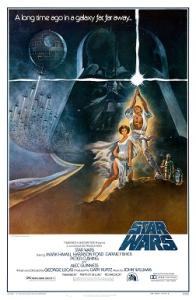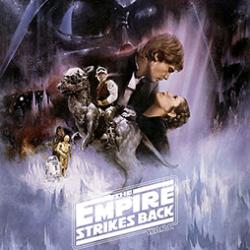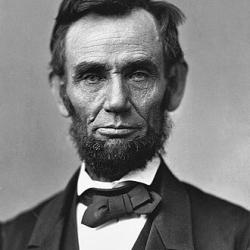On March 2, 2025 the Oscar Academy turned 97.
For almost a century the movie industry in Hollywood has been turning out awards
for what it considers the best in quality film making in the ceremony that is
the superbowl of movies.
Some of those movies we’ve all seen, a lot more we haven’t.
There have been 100’s of pictures nominated over the years and
I’m sure a good amount of them you’ve never heard of.
On the occasion of the 97th academy awards
I’m going to mention some highlights of
some Memorable Academy Award Nominated Films
of the first 50 years of the ceremonies.
I don’t list every great movie or every best picture.
In a few places I list only some titles.
Keep in mind as of March 05, 2025:
Total number of awards ceremonies: 97
Total number of nominated films: 5,182
Total number of nominations given to films: 10,651
Total number of Oscars awarded: 2,239 (57 honorary and 2,182 competitive)
Included in this list are some great
cosmic adventures, comedies, cartoons and Catholic Saints.
There might be a follow up post of the 2nd 50 years of highlights.
Like making an Oscar winning movie it takes real time and hard work
to write an interesting article worth reading.
I just patched this together, which still took time and hard work.
I can’t make my desired deadline on the day after the Oscars to
write the follow up post of the next 50 years of Academy Award winners.
It’s late at night, I’m tired and my feet hurt from working all day.
But like the Oscars themselves, there are winners and there are losers.
So………………….
What films have you seen or heard of?
What films might you want to see after reading this list?
What films did I leave out you think should be here?
Descriptions of films are from Wikipedia and IMDB.
List of Academy Award–nominated films
1920’s
1st Academy Awards
The 1st Academy Awards ceremony, presented by the Academy of Motion Picture Arts and Sciences (AMPAS) and hosted by AMPAS president Douglas Fairbanks, honored the best films from 1 August 1927 to 31 July 1928 and took place on May 16, 1929, at a private dinner held at the Hollywood Roosevelt Hotel in Los Angeles, California. Tickets cost $5 ($85 in 2022, considering inflation); 270 people attended the event, which lasted 15 minutes. It is the only Academy Awards ceremony not broadcast on either radio or television; a radio broadcast was introduced for the 2nd Academy Awards.
Wings (1927) Outstanding Picture
Two young men, one rich, one middle class, who are in love with the same woman, become fighter pilots in World War I.
Wins won inaugural Academy Award for Outstanding Picture at the first Academy of Motion Picture Arts and Sciences award ceremony in 1929, and is the only fully silent film to do so. It also won the Academy Award for Best Engineering Effects (Roy Pomeroy). Wings was one of the first widely released films to show nudity. In 1997, Wings was selected for preservation in the United States National Film Registry by the Library of Congress as being “culturally, historically, or aesthetically significant”
The film entered the public domain in the United States in 2023.
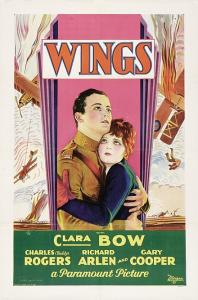
Best Unique and Artistic Picture
Sunrise (1927)
A sophisticated city woman seduces a farmer and convinces him to murder his wife and join her in the city, but he ends up rekindling his romance with his wife when he changes his mind at the last moment.
Outstanding Picture Nominee
7th Heaven (1927)
A street cleaner saves a young woman’s life, and the pair slowly fall in love until war intervenes.
The Crowd (1928)
The life of a man and woman together in a large, impersonal metropolis through their hopes, struggles, and downfalls.
It was several awards, including Unique and Artistic Production for MGM and Best Director for King Vidor.
Among first 25 selected by the Library of Congress for preservation in the United States National Film Registry for being “culturally, historically, or aesthetically significant”.
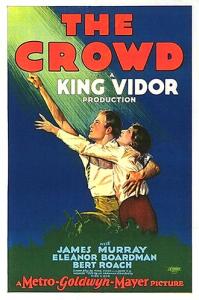
Speedy (1928) starring Harold Lloyd
Nominee Best Directing (Comedy Picture)
This is a Harold Lloyd comedy. It was Lloyd’s last silent film before he converted to sound production. Due to the general public’s apathy towards silent films, a sound version was prepared and released in the latter half of 1928.
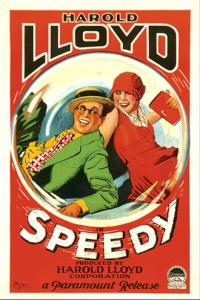
Two Arabian Knights (1927) Best Comedy Direction
This film won the only Academy Award for Best Comedy Direction in 1929. The next year, AMPAS merged the categories Best Director of a Comedy Picture and Best Director of a Dramatic Picture to form the category Academy Award for Best Director.
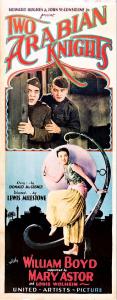
Chang: A Drama of the Wilderness (1927)
nominated for Unique and Artistic Production
the only time that award was presented.
It is a silent documentary film about a poor farmer in northern Nan Province (northern Thailand) and his daily struggle for survival in the jungle.
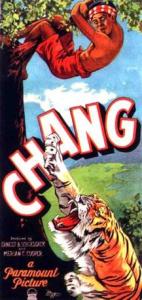
1st Talking Picture
The Jazz Singer (1927)
Special Award To Warner Bros. for producing The Jazz Singer,
the pioneer outstanding talking picture, which has revolutionized the industry.[
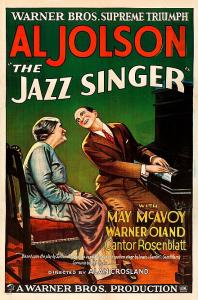
The Circus (1928) Special Academy Award
To Charlie Chaplin
for acting, writing, directing and producing The Circus.
The ringmaster of an impoverished circus hires Chaplin’s Little Tramp as a clown, but discovers that he can only be funny unintentionally.
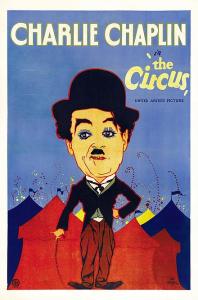
The Last Command (1928)
The film stars Emil Jannings, who won the first Academy Award for Best Actor in a Leading Role at the 1929 ceremony for his performances in this film and The Way of All Flesh, the only year multiple roles were considered. Evelyn Brent and William Powell co-star.
In 2006, the film was deemed “culturally, historically, or aesthetically significant” by the United States Library of Congress and selected for the National Film Registry.
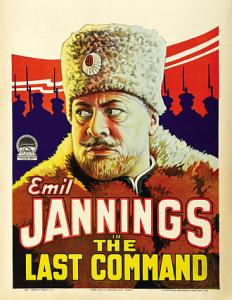
2nd Academy Awards

The first sound film to win an Academy Award for Best Picture.
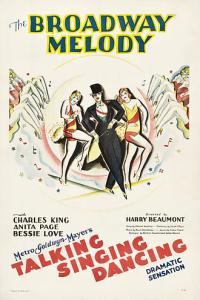
White Shadows in the South Seas (1928)
While the film has no audible dialog, it was released with a synchronized musical score with sound effects using the sound-on-film Western Electric Sound System process. Loosely based on the travel book of the same name by Frederick O’Brien, this film is important historically for being the first sound MGM film to be released with a pre-recorded soundtrack. Clyde De Vinna won an Academy Award for Best Cinematography
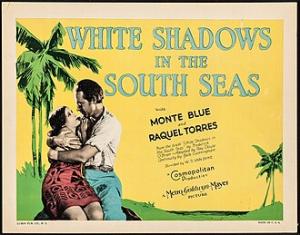
The film closely follows the bestselling 1927 Thornton Wilder novel of the same name and won the second Academy Award for Best Art Direction.

The film stars silent star Mary Pickford in her first talkie, Johnny Mack Brown in one of his earliest roles, John St. Polis, Matt Moore (Pickford’s ex brother in law), and Louise Beavers.
The film was adapted for the screen by John Grey, Allen McNeil and Sam Taylor from the play by George Abbott and Ann Preston Bridgers, and was directed by Sam Taylor. The play was based on real events in Richmond County, North Carolina and some dialog was used verbatim from court testimony.[4] The play originally opened in New York City on November 8, 1927, with Helen Hayes in the title role.
Though a product of pre-Code Hollywood, the film was severely censored during scripting. In the play, the leading lady is pregnant and the story hinges on the fact that she carries the child of the man killed by her father. Her father murdered the man because he asked to marry the girl. But to save her father from disgrace when her pregnancy becomes apparent, she preemptively kills herself. Wrote Ernst and Lorentz, “the censor conscious producer would not allow the movie to show the girl enceinte, thus destroying the whole plot.”

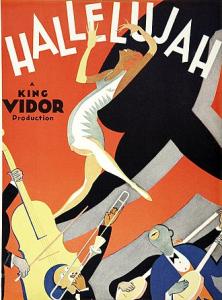
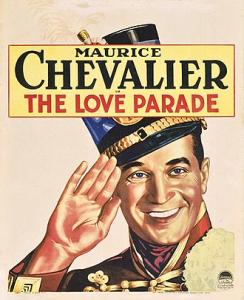
1930’s
- All Quiet on the Western Front (1930) 3rd Academy Award for Outstanding Production.
- With Byrd at the South Pole (1930)–The film was the first documentary to win any Oscar and the only one to win cinematography.
- Skippy (1931) For his performance, Cooper, at the age of nine, became the youngest person to earn an Academy Award nomination for Best Actor in a Leading Role. The film was also nominated for the Academy Award for Best Picture.
- The Champ (1931) It was a pre-Code film starring Wallace Beery and Jackie Cooper and directed by King Vidor from a screenplay by Frances Marion, Leonard Praskins and Wanda Tuchock. The picture tells the story of a washed-up alcoholic boxer (Beery) attempting to put his life back together for the sake of his young son (Cooper). Beery won the Academy Award for Best Actor for his performance (sharing the prize with Fredric March for Dr. Jekyll and Mr. Hyde), Frances Marion won the Academy Award for Best Story, and the film was nominated for the Academy Award for Best Picture and Best Director.
- Dr. Jekyll and Mr. Hyde (1931) It was directed by Rouben Mamoulian and starring Fredric March, who plays a possessed doctor who tests his new formula that can unleash people’s inner demons. The film is an adaptation of The Strange Case of Dr. Jekyll and Mr. Hyde, the 1886 Robert Louis Stevenson tale of a man who takes a potion which turns him from a mild-mannered man of science into a homicidal maniac. The film was a critical and commercial success upon its release. Nominated for three Academy Awards, March won the award for Best Actor, sharing the award with Wallace Beery for The Champ.
- Shanghai Express (1932) It was a pre-Code film about a group of train passengers held hostage by a warlord during the Chinese Civil War. It got 3 Nominations and a win for Best Cinematography. Shanghai Express is memorable for its stylistic black-and-white chiaroscuro cinematography.
Flowers and Trees (1932)
Walt Disney Productions
Flowers and Trees is a Silly Symphonies cartoon produced by Walt Disney, directed by Burt Gillett, and released to theatres by United Artists on July 30, 1932. In the cartoon A jealous stump threatens two trees that are in love by starting a forest fire. When the rain comes and puts out the fire the forest revives and celebrates the wedding, It was the first commercially released film to be produced in the full-color three-strip Technicolor process after several years of two-color Technicolor films. The film was a commercial and critical success, winning the first Academy Award for Best Cartoon Short Subject.
In 2021, the film was selected for preservation in the United States National Film Registry by the Library of Congress for being “culturally, historically, or aesthetically significant”.
As a work from 1932 that had its copyright renewed, the film’s copyright in the United States will expire on January 1, 2028.
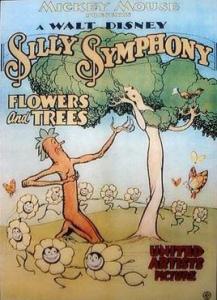
Sign of the Cross (1932)
A Roman soldier becomes torn between his love for a Christian woman and his loyalty to Emperor Nero.
Produced and directed by Cecil B. DeMille this film; the reaction of the Catholic Church in the United States to the content in this film and in Ann Vickers (1933) helped lead to the 1934 formation of the Catholic Legion of Decency, an organization dedicated to identifying and combating objectionable content, from the point of view of the Church, in motion pictures. It is the third and last in DeMille’s biblical trilogy, following The Ten Commandments (1923) and The King of Kings (1927).
It was a Nominee Best Cinematography.
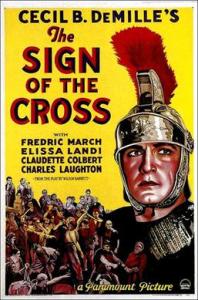
The Music Box (1932)
Like the legendary Sisyphus, deliverymen Laurel and Hardy struggle to push a large crated piano up a seemingly insurmountable flight of stairs.
It won the first Academy Award for Best Live Action Short (Comedy) in 1932. In 1997, it was selected for preservation in the National Film Registry by the Library of Congress as being “culturally, historically, or aesthetically significant”. The film is widely seen as the most iconic Laurel and Hardy short, with the featured stairs becoming a popular tourist attraction.
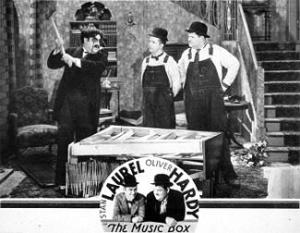
Little Women (1933) 3 Nominations
This is a pre-Code drama film directed by George Cukor, and starring Katharine Hepburn, Joan Bennett, Frances Dee, and Jean Parker. The screenplay, written by Sarah Y. Mason and Victor Heerman, is based on the 1868-1869 two-volume novel of the same name by Louisa May Alcott.
This is the third screen adaptation of the book. It follows two silent versions: the first released in 1917 with Minna Grey, and the second in 1918 with Dorothy Bernard. After this 1933 sound version came the 1949 Little Women, with June Allyson, Elizabeth Taylor, and Peter Lawford, the 1994 film Little Women, starring Winona Ryder, and the 2019 film Little Women, featuring Saoirse Ronan.
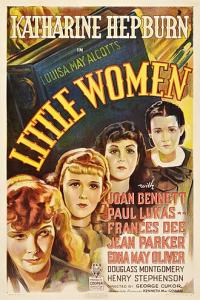
It Happened One Night (1934)
A rogue reporter trailing a runaway heiress for a big story joins her on a bus heading from Florida to New York and they end up stuck with each other when the bus leaves them behind at one of the stops along the way.
It Happened One Night is a American pre-Code romantic comedy film with elements of screwball comedy directed and co-produced by Frank Capra, in collaboration with Harry Cohn, and stars Claudette Colbert and Clark Gable. The screenplay by Robert Riskin is based on the August 1933 short story “Night Bus” by Samuel Hopkins Adams, which provided the shooting title. Classified as a “pre-Code” production, the film is among the last romantic comedies created before the MPPDA began rigidly enforcing the 1930 Motion Picture Production Code in July 1934. It Happened One Night was released just four months prior to that enforcement.
It is seen as one of the greatest films ever made. It Happened One Night is the first of only three films (along with One Flew Over the Cuckoo’s Nest and The Silence of the Lambs) to win all five major Academy Awards: Best Picture, Best Director, Best Actor, Best Actress, and Best Adapted Screenplay. In 1993, it was selected for preservation in the U.S. National Film Registry by the Library of Congress, being deemed “culturally, historically, or aesthetically significant”.
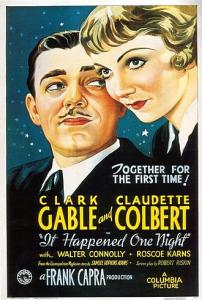
Men in Black (1934)
The stooges become doctors, at a large hospital, where they disrupt patients and staff alike.
Men in Black stars The Three Stooges (Moe Howard, Larry Fine and Jerry Howard). It is the third entry in the series released by Columbia Pictures starring the comedians, who released 190 short subjects for the studio between 1934 and 1959.
Men in Black is the only Stooge film ever nominated for an Academy Award for Best Short Subject – Comedy.

Mutiny on the Bounty (1935)
It was directed by Frank Lloyd and produced by Metro-Goldwyn-Mayer. It dramatizes the mutiny of HMS Bounty, and is adapted from the novels Mutiny on the Bounty and Men Against the Sea by Charles Nordhoff and James Norman Hall. It stars Charles Laughton as William Bligh, Clark Gable as Fletcher Christian, and Franchot Tone as Roger Byam (based on Peter Heywood).
Despite historical inaccuracies, the film was a huge box office success, becoming the highest-grossing film of 1935 and one of MGM’s biggest hits of the 1930s. The film was also a major critical success, and received a leading eight nominations at the 8th Academy Awards, winning Best Picture.

Bride of Frankenstein (1935)
The first sequel to Universal Pictures‘ 1931 film Frankenstein. As with the first film, Bride of Frankenstein was directed by James Whale starring Boris Karloff as the Monster and Colin Clive as Dr. Frankenstein. The sequel features Elsa Lanchester in the dual role of Mary Shelley and the bride. Colin Clive reprises his role as Henry Frankenstein, and Ernest Thesiger plays the role of Doctor Septimus Pretorius. Oliver Peters Heggie plays the role of the old blind hermit.
Taking place immediately after the events of the earlier film, it is rooted in a subplot of the original Mary Shelley novel, Frankenstein; or, The Modern Prometheus (1818). Its plot follows a chastened Henry Frankenstein as he attempts to abandon his plans to create life, only to be tempted and finally blackmailed by his old mentor Dr. Pretorius, along with threats from the Monster, into constructing a bride for the Monster.
In 1998, it was selected by the Library of Congress for preservation in the United States National Film Registry, having been deemed “culturally, historically or aesthetically significant”.
Bride was nominated for one Academy Award, for Sound Recording (Gilbert Kurland).
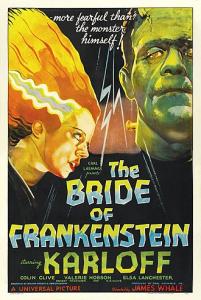
La Fiesta de Santa Barbara (1935)
It was nominated for an Academy Award at the 9th Academy Awards in 1936 for Best Short Subject (Color). It features a 13-year-old Judy Garland singing “La Cucaracha” with her two sisters (billed as The Garland Sisters).
Hollywood stars participate in a Mexican-themed revue and festival in Santa Barbara. Andy Devine, the “World’s Greatest Matador”, engages in a bullfight with a dubious bovine supplied by Buster Keaton, and musical numbers are provided by Joe Morrison and The Garland Sisters. Comedy bits and dance numbers are also featured. It also has appearances by the creator of The Three Stooges, Ted Healy, Warner Baxter, Gary Cooper, and Harpo Marx.
The film was selected for the National Film Registry by the Library of Congress, which has prompted further preservation efforts to maintain both original film elements and restored versions.
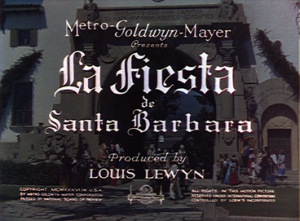
- San Francisco (1936) This is a musical–drama disaster film directed by W. S. Van Dyke, based on the April 18, 1906 San Francisco earthquake. The film stars Clark Gable, Jeanette MacDonald and Spencer Tracy as Father Tim Mullin. MacDonald’s singing helped make this film a major hit, coming on the heels of her other 1936 blockbuster, Rose Marie. The film won one Academy Award and was nominated for five more.
- Mr. Deeds Goes to Town is another Acadadmy Award winning film directed by Frank Capra and starring Gary Cooper and Jean Arthur in her first featured role. Based on the 1935 short story “Opera Hat” by Clarence Budington Kelland, which appeared in serial form in The American Magazine, the screenplay was written by Robert Riskin in his fifth collaboration with Capra. The film won one Academy Award for best director and was nominated for four more.
- The Story of Louis Pasteur (1936) This is a biographical film directed by William Dieterle, that stars Paul Muni as the renowned scientist who developed major advances in microbiology, which revolutionized agriculture and medicine. The film’s screenplay—which tells a highly fictionalized version of Pasteur’s life—was written by Pierre Collings and Sheridan Gibney, and Edward Chodorov (uncredited). Muni won an Academy Award for Best Actor, while Collings and Gibney won for Best Screenplay and Best Story. The film was nominated for Best Picture.
Bored of Education (1936)
Bored of Education is a Our Gang short comedy film directed by Gordon Douglas. Produced by Hal Roach and released to theaters by Metro-Goldwyn-Mayer, it was the 146th entry in the Our Gang series to be released.
Bored of Education won Roach the Academy Award for Short Subjects (One-Reel), the only Our Gang film so honored. It won Hal Roach his only Academy Award for Our Gang, the 1937 Academy Award for Short Subjects (One-Reel).In their review for the short in their book The Little Rascals: The Life and Times of Our Gang, film historians Leonard Maltin and Richard W. Bann felt that the award seemed to be “a product of whim or timing, rather than strictly a consideration of merit”, noting earlier and later shorts–Teacher’s Pet among them–they felt were overlooked.
Bored of Education was preserved by the Academy Film Archive, in conjunction with the UCLA Film and Television Archive, in 2013.
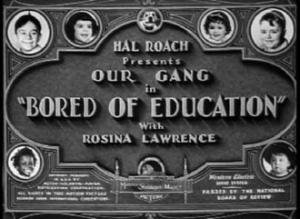
Walt Disney‘s
Snow White and the Seven Dwarfs (1937)
This was the world’s first full-length Technicolor animated feature film with sound and widely seen as one of the greatest motion pictures of all time, received only one nomination, for Best Original Score. The following year, the Academy presented Disney an Honorary Academy Award (consisting of one full-size Oscar statuette and seven miniature statuettes on a stepped base) “for creating Snow White and the Seven Dwarfs [1937], recognized as a significant screen innovation which has charmed millions and pioneered a great new entertainment field for the motion picture cartoon”. This is a rare case of a film being recognized in two successive ceremonies.
It came out the same year as John Steinbeck‘s novella of the Great Depression, Of Mice and Men.
It came out the same year the J. R. R. Tolkien‘s juvenile fantasy novel The Hobbit, or There and Back Again was published.
And it was released on December 21, 1937, the same day Dr. Seuss‘s first book, And to Think That I Saw It on Mulberry Street, was published.
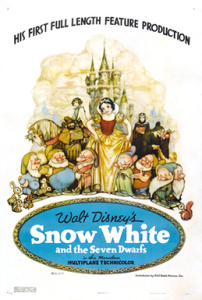
- A Star Is Born (1937) It starred Janet Gaynor (in her only Technicolor film) as an aspiring Hollywood actress, and Fredric March (in his Technicolor debut) as a fading movie star who helps launch her career. The supporting cast features Adolphe Menjou, May Robson, Andy Devine, Lionel Stander, and Owen Moore. At the 10th Academy Awards, it became the first color film to be nominated for the Academy Award for Best Picture. The movie’s plot is heavily based on a previous Hollywood production, What Price Hollywood?, released in 1932 though not as widely known. This movie however would garner popularity and kickstart a legacy which led to it being remade three times: in 1954 (directed by George Cukor and starring Judy Garland and James Mason), in 1976 (directed by Frank Pierson and starring Barbra Streisand and Kris Kristofferson), and in 2018 (starring Lady Gaga and Bradley Cooper, who also directed). Unlike the original film, the three remakes are all musical films.
- Captain Courageous (1937) It starring Freddie Bartholomew, Spencer Tracy, Lionel Barrymore and Melvyn Douglas. It is based on the 1897 novel of the same name by Rudyard Kipling and was directed by Victor Fleming. The film was nominated for four Academy Awards, with Spencer Tracy winning the Best Actor Oscar for his portrayal of the simple but caring fisherman Manuel. Backgrounds and exteriors for the film, which updated the story’s setting to the mid-1920s, were shot on location in Port aux Basques, Newfoundland and Shelburne, Nova Scotia in Canada, and Gloucester, Massachusetts in the United States.
- The Good Earth (1937) It is about Chinese farmers who struggle to survive. It was adapted by Talbot Jennings, Tess Slesinger, and Claudine West from the 1932 play by Owen Davis and Donald Davis, which was in itself based on the 1931 novel of the same name by Nobel Prize-winning author Pearl S. Buck. The film was directed by Sidney Franklin, with uncredited contributions by Victor Fleming and Gustav Machaty. The film stars Paul Muni as Wang Lung. For her role as his wife O-Lan, Luise Rainer won an Academy Award for Best Actress. The film also won the Academy Award for Best Cinematography for Karl Freund. It was nominated for Best Director, Best Film Editing, and Best Picture.
Boys Town (1938)
When a death row prisoner tells him he wouldn’t have led a life of crime if only he had had one friend as a child, Father Edward Flanagan decides to start a home for young boys.
Spencer Tracy won the Academy Award for Best Actor for his performance as Father Edward J. Flanagan. It also starred Mickey Rooney
Metro-Goldwyn-Mayer Studio head Louis B. Mayer, who was a Belarusian-Canadian-American Jew known for his respect for the Catholic Church, later called this his favorite film of his long tenure at MGM.

The Real Right Rev. Monsignor Edward Joseph Flanagan (July 13, 1886 – May 15,1948) was an Irish-born priest of the Catholic Church in the United States who served for decades in Nebraska. After serving as a parish priest in the Catholic Diocese of Omaha, he founded the orphanage and educational complex known as Boys Town, located west of the city in what is now Boys Town, Douglas County, Nebraska. In the 21st century, the complex also serves as a center for troubled youth.
Flanagan’s work became widely known, especially after he was played by Spencer Tracy in the movie Boys Town (1938). In the post-World War II era, Flanagan was invited by General Douglas MacArthur to visit Japan and Korea, and later Austria and Germany, to give him advice about improving conditions for children in the occupied countries.
In 2012 the Catholic Diocese of Omaha initiated the process for canonization of Fr. Flanagan. That year he was declared a “Servant of God”. Documentation of the cause was sent to the Vatican in 2015.
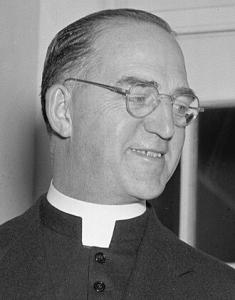
A Day at the Races (1937)
A veterinarian posing as a doctor teams with a singer and his friends as they struggle to save an upstate New York sanitarium with the help of a misfit racehorse. It is the seventh film starring the Marx Brothers (Groucho, Harpo and Chico),
The dance sequence for “All God’s Chillun Got Rhythm” was nominated for the short-lived Academy Award for Best Dance Direction, only given from 1935 to 1937.
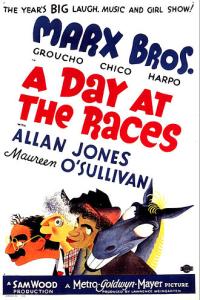
Good Scouts (1938)
Good Scouts is a American animated short film produced by Walt Disney Productions and released by RKO Radio Pictures.[1] The cartoon follows Donald Duck leading his nephews Huey, Dewey, and Louie on a scouting trip through the wilderness. It was directed by Jack King and features Clarence Nash as Donald and the three nephews.
Good Scouts was nominated for an Academy Award for Best Animated Short Film at the 11th Academy Awards in 1939, but lost to Disney’s own Ferdinand the Bull. Also nominated that year from Disney were Brave Little Tailor and Mother Goose Goes Hollywood, setting the record for most nominations in the category for one studio. Good Scouts was the first Academy Award nomination for the Donald Duck series.
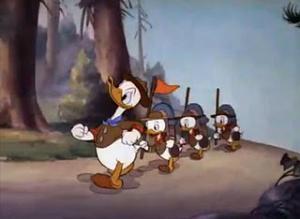
- You Can’t Take It with You (1938) is another Academy Award winning film directed by Frank Capra, and starring Jean Arthur, Lionel Barrymore, James Stewart, and Edward Arnold. Adapted by Robert Riskin from the Pulitzer Prize-winning 1936 play of the same name by George S. Kaufman and Moss Hart, the film is about a man from a family of rich snobs who becomes engaged to a woman from a good-natured but decidedly eccentric family. A critical and commercial success, the film received two Academy Awards: Best Picture and Best Director for Frank Capra. This was Capra’s third Oscar for Best Director in just five years, following It Happened One Night (1934) and Mr. Deeds Goes to Town (1936).
- The Adventures of Robin Hood (1938) It stars Errol Flynn as the legendary Saxon knight Robin Hood, who in Richard I‘s absence in the Holy Land during the Crusades, fights back as the outlaw leader of a rebel guerrilla band against Prince John and the Norman lords oppressing the Saxon commoners. The cast also includes Olivia de Havilland, Basil Rathbone, Claude Rains, Patric Knowles, Eugene Pallette, and Alan Hale. Upon its premiere on May 14, 1938, The Adventures of Robin Hood was very well received by critics. The film was a commercial success; it grossed around $4 million at the box office, making it one of the highest grossers of 1938. At the 11th Academy Awards, it received four nominations, winning three—Best Art Direction (Carl Jules Weyl), Best Film Editing (Ralph Dawson) and Best Original Score (Erich Wolfgang Korngold). In 1995, The Adventures of Robin Hood was deemed “culturally, historically, or aesthetically significant” by the Library of Congress and selected for preservation by the National Film Registry.
Gone with the Wind (1939)
A sheltered and manipulative Southern belle and a roguish profiteer face off in a turbulent romance as the society around them crumbles with the end of slavery and is rebuilt during the Civil War and Reconstruction periods. It was directed by Victor Fleming who also directed another academy award nominated film for best picture,
The Wizard of Oz (1939)
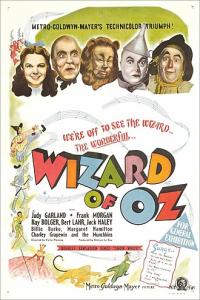
Gone With the Wind is set in the American South against the backdrop of the American Civil War and the Reconstruction era, the film tells the story of Scarlett O’Hara (Vivien Leigh), the strong-willed daughter of a Georgia plantation owner, following her romantic pursuit of Ashley Wilkes (Leslie Howard), who is married to his cousin, Melanie Hamilton (Olivia de Havilland), and her subsequent marriage to Rhett Butler (Clark Gable).
Gone with the Wind received ten Academy Awards (eight competitive, two honorary) from thirteen nominations, including wins for Best Picture, Best Director (Fleming), Best Adapted Screenplay (posthumously awarded to Sidney Howard), Best Actress (Leigh), and Best Supporting Actress (Hattie McDaniel, becoming the first African American to win an Academy Award). It set records for the total number of wins and nominations at the time.
The year 1939 in film is widely considered the greatest year in film history. Wizard and Wind are 2 out of the ten films nominated for Best Picture at the 12th Academy Awards (which honored the best in film for 1939). The others Dark Victory, Goodbye, Mr. Chips, Love Affair, Mr. Smith Goes to Washington, Ninotchka, Of Mice and Men, Stagecoach, and Wuthering Heights—range in genre and are considered classics.

Mr. Smith Goes to Washington (1939)
Mr. Smith Goes to Washington is a 1939 American political comedy-drama film directed by Frank Capra, starring Jean Arthur and James Stewart, and featuring Claude Rains and Edward Arnold. The film is about a naive, newly appointed United States senator who fights against government corruption, and was written by Sidney Buchman, based on Lewis R. Foster‘s unpublished story “The Gentleman from Montana”. It was loosely based on the life of Montana US Senator Burton K. Wheeler, who underwent a similar experience when he was investigating the Warren Harding administration.
The film was controversial in the US when it was first released, with attacks from many politicians claiming that it brought Washington into disrepute, but it was very successful at both the domestic and international box offices, and it made Stewart a major star.
Mr. Smith Goes to Washington was nominated for eleven Academy Awards, including Best Picture, Best Director and Best Actor, winning Best Original Story. Considered to be one of the greatest films of all time, the film was selected by the Library of Congress as one of the first 25 films for preservation in the United States National Film Registry in 1989, for being “culturally, historically, or aesthetically significant”.
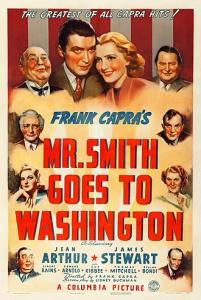
1940’s
The Great Dictator (1940)
This was directed, produced by, and starring Charlie Chaplin. Having been the only Hollywood filmmaker to continue to make silent films well into the period of sound films, Chaplin made this his first true sound film.
Chaplin’s film advanced a stirring condemnation of the German and Italian dictators Adolf Hitler and Benito Mussolini, as well as fascism, antisemitism, and the Nazism. At the time of its first release, the United States was still at peace with Nazi Germany and neutral during what were the early days of World War II. Chaplin plays both leading roles: a ruthless fascist dictator and a persecuted Jewish barber.
The Great Dictator was popular with audiences, becoming Chaplin’s most commercially successful film.[4] Modern critics have praised it as a historically significant film, one of the greatest comedy films ever made and an important work of satire. In 1997, it was selected by the Library of Congress for preservation in the United States National Film Registry as being “culturally, historically, or aesthetically significant”. The Great Dictator was nominated for five Academy Awards – Outstanding Production, Best Actor, Best Writing (Original Screenplay), Best Supporting Actor for Jack Oakie, and Best Music (Original Score).
In his 1964 autobiography, Chaplin stated that he could not have made the film if he had known about the true extent of the horrors of the Nazi concentration camps at that time.
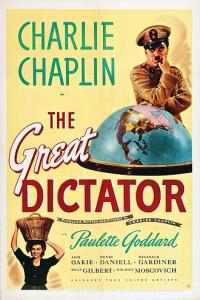
Rebecca (1940)
This was a romantic psychological thriller film directed by Alfred Hitchcock. It was Hitchcock’s first American project, and his first film under contract with producer David O. Selznick. The screenplay by Robert E. Sherwood and Joan Harrison, and adaptation by Philip MacDonald and Michael Hogan, were based on the 1938 novel of the same name by Daphne du Maurier.
The film stars Laurence Olivier as the brooding, aristocratic widower Maxim de Winter and Joan Fontaine as the young, never-named woman who becomes his second wife, with Judith Anderson, George Sanders and Gladys Cooper in supporting roles. The film is a gothic tale shot in black-and-white. Maxim de Winter’s first wife Rebecca, who died before the events of the film, is never seen. Her reputation and recollections of her, however, are a constant presence in the lives of Maxim, his new wife and the housekeeper, Mrs. Danvers.
Rebecca was theatrically released on April 12, 1940, to critical and commercial success. It received eleven nominations at the 13th Academy Awards, more than any other film that year. It won two awards; Best Picture, and Best Cinematography, becoming the only film directed by Hitchcock to win the former award. In 2018, the film was selected for preservation in the United States National Film Registry by the Library of Congress as being “culturally, historically, or aesthetically significant”.

- The Grapes of Wrath (1940) directed by John Ford. It was based on John Steinbeck‘s 1939 Pulitzer Prize-winning novel of the same name. The film tells the story of the Joads, an Oklahoma family of sharecroppers, who, after losing their farm to increased mechanization during the Great Depression in the 1930s, become migrant workers, and end up in California. The motion picture details their arduous journey across the United States as they travel to California in search of work and opportunities for the family members, and features cinematography by Gregg Toland. The film is widely considered to be one of the greatest films of all time. In 1989, it was one of the first 25 films selected by the Library of Congress for preservation in the United States National Film Registry for being “culturally, historically, or aesthetically significant”.
- The Philadelphia Story (1940) is a 1940 American romantic comedy film starring Cary Grant, Katharine Hepburn, James Stewart and Ruth Hussey. Nominated for six Academy Awards, including Outstanding Production (Best Picture), the film won two: Best Actor (Stewart) and Best Adapted Screenplay. MGM remade the film in 1956 as a musical retitled High Society, starring Bing Crosby, Grace Kelly and Frank Sinatra.
- Boom Town (1940) This is a Western film starring Clark Gable, Spencer Tracy, Claudette Colbert, and Hedy Lamarr, and directed by Jack Conway. Harold Rosson was nominated for the Academy Award for Best Cinematography (Black-and-White), and A. Arnold Gillespie (photographic effects) and Douglas Shearer (sound effects) were nominated for Best Special Effects.
- Abe Lincoln in Illinois (1940) This is a biographical-drama film that depicts the life of Abraham Lincoln from his departure from Kentucky until his election as president of the United States. The film received Academy Award nominations for Best Actor in a Leading Role (Raymond Massey) and Best Cinematography, Black-and-White (James Wong Howe).
- Edison, the Man (1940) This is a biographical film depicting the life of inventor Thomas Edison, who was portrayed by Spencer Tracy. Hugo Butler and Dore Schary were nominated for the Academy Award for Best Writing, Original Story for their work on this film. Typical of most Hollywood biopics, much of the film fictionalizes or exaggerates the real events of Edison’s life. Edison, the Man was the second of a complementary pair of Edison biopics released by Metro-Goldwyn-Mayer in 1940. Young Tom Edison, starring Mickey Rooney, was released two months earlier and told the story of Edison’s youth.
Fantasia(1940)
This is a animated musical anthology film produced by Walt Disney Productions, with story direction by Joe Grant and Dick Huemer and production supervision by Walt Disney and Ben Sharpsteen. It consists of eight animated segments set to pieces of classical music conducted by Leopold Stokowski, seven of which are performed by the Philadelphia Orchestra. Music critic and composer Deems Taylor acts as the film’s Master of Ceremonies who introduces each segment in live action.
Fantasia was the subject of two Academy Honorary Awards on February 26, 1942—one for Disney, William Garity, John N. A. Hawkins, and the RCA Manufacturing Company for their “outstanding contribution to the advancement of the use of sound in motion pictures through the production of Fantasia“, and the other to Stokowski “and his associates for their unique achievement in the creation of a new form of visualized music in Walt Disney’s production Fantasia, thereby widening the scope of the motion picture as entertainment and as an art form”.
In 1990, Fantasia was selected for preservation in the United States National Film Registry by the Library of Congress as being “culturally, historically, or aesthetically significant”. On the 100th anniversary of cinema in 1995, the Vatican included Fantasia in its list of 45 “great films” made under the Art category (the other categories being Religion and Values).
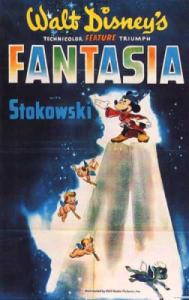
Citizen Kane (1941)
Following the death of publishing tycoon Charles Foster Kane, reporters scramble to uncover the meaning of his final utterance: ‘Rosebud.’
Citizen Kane is frequently cited as the greatest film ever made but it failed to win Best Picture, losing to John Ford‘s How Green Was My Valley (1941). It was directed by, produced by and starring Orson Welles and co-written by Welles and Herman J. Mankiewicz. It was Welles’s first feature film. The film was nominated for Academy Awards in nine categories and it won for Best Writing (Original Screenplay) by Mankiewicz and Welles.
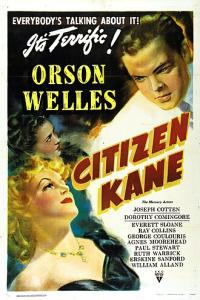
Buck Privates (1941)
This is the film that turned Bud Abbott and Lou Costello into bona fide movie stars. It was the first service comedy based on the peacetime draft of 1940. The comedy team made two more service comedies before the United States entered the war (In the Navy and Keep ‘Em Flying). A sequel to this movie, Buck Privates Come Home, was released in 1947. Buck Privates is one of three Abbott and Costello films featuring The Andrews Sisters, who were also under contract to Universal Pictures at the time.
The film received two Academy Award nominations in 1941. Hughie Prince and Don Raye were nominated for the Academy Award for Best Original Song for “Boogie Woogie Bugle Boy” and Charles Previn was nominated for the Academy Award for Original Music Score (Scoring of a Musical Picture).

- Dr. Jekyll and Mr. Hyde (1941) This version of the Robert Louis Stevenson book starred Spencer Tracy, Ingrid Bergman, and Lana Turner. This movie was a remake of the Oscar-winning 1931 version starring Fredric March Released in August 1941, Dr. Jekyll and Mr. Hyde was a commercial success, and was nominated for three Academy Awards.
- Sergeant York (1941) biographical film about the life of Alvin C. York, one of the most decorated American soldiers of World War I. Directed by Howard Hawks and starring Gary Cooper in the title role, the film was a critical and commercial success, and became the highest-grossing film of 1941. In 2008, Sergeant York was selected for preservation in the United States National Film Registry by the Library of Congress as being “culturally, historically, or aesthetically significant”. Cooper went on to win the Academy Award for Best Actor for his performance, while the film also won Best Film Editing and was nominated in nine other categories, including Best Picture, Director, Supporting Actor (Walter Brennan), and Supporting Actress (Margaret Wycherly). The American Film Institute ranked the film 57th in its 100 most inspirational American movies list; it also rated Alvin York 35th in its list of the top 50 heroes in American cinema.
- The Maltese Falcon (1941) This is a film noir written and directed by John Huston in his directorial debut. Based on the 1930 novel The Maltese Falcon by Dashiell Hammett, it is a remake of the 1931 film of the same name. Starring Humphrey Bogart as private investigator Sam Spade, Mary Astor as his femme fatale client, and Peter Lorre and Sydney Greenstreet as villains, the film follows a life-and-death quest for a jewel-encrusted falcon statuette in San Francisco. The film premiered in New York City on October 3, 1941, and was an immediate success, eventually becoming one of the first 25 films selected by the Library of Congress to be included in the National Film Registry as “culturally, historically, or aesthetically significant” in 1989. For the 14th Academy Awards, the film was nominated for Best Picture, Greenstreet was nominated for Best Supporting Actor, and Huston for Best Adapted Screenplay.
15th Academy Awards
The Gold Rush (1925/1942)
The Gold Rush is a American silent comedy film written, produced, and directed by Charlie Chaplin. The film also stars Chaplin in his Little Tramp persona, Georgia Hale, Mack Swain, Tom Murray, Henry Bergman and Malcolm Waite.
Chaplin drew inspiration from photographs of the Klondike Gold Rush as well as from the story of the Donner Party who, when snowbound in the Sierra Nevada, were driven to cannibalism or eating leather from their shoes. Chaplin, who believed tragedies and comedies were not far from each other, decided to combine these stories of deprivation and horror in comedy. He decided that his famous rogue figure should become a gold-digger who joins a brave optimist determined to face all the pitfalls associated with the search for gold, such as sickness, hunger, cold, loneliness or the possibility that he may at any time be attacked by a grizzly. In the film, scenes like Chaplin cooking and dreaming of his shoe, or how his starving friend Big Jim sees him as a chicken could be seen.
The Gold Rush was critically acclaimed upon its release, and continues to be one of Chaplin’s most celebrated works; Chaplin himself cited it several times as the film for which he most wanted to be remembered. In 1942, Chaplin re-released a version with sound effects, music, and narration, which received Academy Award nominations for Best Music Score and Best Sound Recording. In 1958, the film was voted number 2 on the prestigious Brussels 12 list at the 1958 World Expo, by a margin of only five votes behind Battleship Potemkin. In 1992, the film was selected for preservation in the United States National Film Registry by the Library of Congress as being “culturally, historically, or aesthetically significant”.
In 1953, the original 1925 version of the film entered the public domain in the United States because the claimants did not renew its copyright registration in the 28th year after publication.

Hellzapoppin (1942)
This is a musical comedy film, and an adaptation of the stage musical of the same name that ran on Broadway from 1938 to 1941. It starred Ole Olsen and Chic Johnson, The film is deliberately nonsensical, with the comedians stopping the film to address both the movie audience and the projection booth (breaking the fourth wall); trick photography embellishing the visual gags; and the traditional romantic subplot ridiculed as it unfolds.
The 1942 Academy Awards nomination for Best Song of “Pig Foot Pete” (which lost to “White Christmas“), was attributed to Hellzapoppin’; however, the song never appears in the film—it was actually performed in the Abbott and Costello film Keep ‘Em Flying, another Universal Pictures production from 1941. The official Academy Awards database credits Hellzapoppin’ with the Best Song nomination but comments in a note, “This nomination is a mystery. Both the nominations list and the program from the Awards dinner list the song as being from Hellzapoppin’, a 1942 release for Awards purposes.”
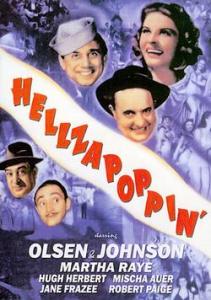
- George Washington Slept Here (1942) When Bill and Connie Fuller are forced to move out of their Manhattan apartment because of their pet dog, Connie purchases a dilapidated old Pennsylvania house where George Washington allegedly slept, and persuades Bill to renovate it. This is a Jack Benny comedy. George Washington Slept Here was nominated for an Oscar for Best Art Direction for Max Parker, Mark-Lee Kirk and Casey Roberts.
- Road to Morocco (1942) starring Bing Crosby, Bob Hope and Dorothy Lamour, and featuring Anthony Quinn and Dona Drake. Written by Frank Butler and Don Hartman and directed by David Butler, it’s the third of the “Road to …” films. It was preceded by Road to Zanzibar (1941) and followed by Road to Utopia (1946). The story is about two fast-talking guys cast away on a desert shore and sold into slavery to a princess. In 1996, Road to Morocco was selected for preservation in the United States National Film Registry by the Library of Congress as being “culturally, historically, or aesthetically significant”. The picture received Oscar nominations for Best Sound Recording (Loren L. Ryder) and Best Writing, Original Screenplay. Road to Morocco featured the first affectionate interracial kiss (between Bob Hope and Dona Drake) in film. Previously in 1934, the movie Java Head had a quick kiss between married characters Anna Mae Wong and Gerrit Ammidon.
- Yankee Doodle Dandy (1942) This is a biographical musical drama film about George M. Cohan, known as “The Man Who Owned Broadway”. It stars James Cagney, Joan Leslie, Walter Huston, and Richard Whorf, and features Irene Manning, George Tobias, Rosemary DeCamp, Jeanne Cagney, and Vera Lewis. Joan Leslie’s singing voice was partially dubbed by Sally Sweetland. The film was a major hit for Warner Brothers, and was nominated for eight Academy Awards, including Best Picture, winning three. In 1993, Yankee Doodle Dandy was selected for preservation in the United States National Film Registry by the Library of Congress as being “culturally, historically, or aesthetically significant”, and in 1998, the film was included on the American Film Institute‘s 100 Years…100 Movies list, a compilation of the 100 greatest films in American cinema.
- The Pride of the Yankees (1942) This is a sports drama film produced by Samuel Goldwyn, directed by Sam Wood, and starring Gary Cooper, Teresa Wright, and Walter Brennan. It is a tribute to the legendary New York Yankees first baseman Lou Gehrig, who died a year before its release, at age 37, from amyotrophic lateral sclerosis, which later became known to the lay public as “Lou Gehrig’s disease”. Film Editor Daniel Mandell won an Academy Award for his work on The Pride of the Yankees.[19] The film received ten additional Oscar nominations.
This is a musical film starring Bing Crosby and Fred Astaire, with Marjorie Reynolds, Virginia Dale, and Walter Abel. It was directed by Mark Sandrich with music by Irving Berlin. The composer wrote twelve songs specifically for the film, the best known being “White Christmas“. The film features a complete reuse of the song “Easter Parade“, written by Berlin for the 1933 Broadway revue As Thousands Cheer and used as a highlight of the 1948 film Easter Parade, starring Astaire and Judy Garland. The film’s choreography was by Danny Dare.
The film received a 1943 Academy Award for Best Original Song (Berlin’s “White Christmas”), as well as Academy Award nominations for Best Score (Robert Emmett Dolan) and Best Original Story (Irving Berlin).

16th Academy Awards
Casablanca (1942)
It directed by Michael Curtiz and starring Humphrey Bogart, Ingrid Bergman, and Paul Henreid. Filmed and set during World War II, it focuses on an American expatriate (Bogart) who must choose between his love for a woman (Bergman) and helping her husband (Henreid), a Czechoslovak resistance leader, escape from the Vichy-controlled city of Casablanca to continue his fight against the Germans. The screenplay is based on Everybody Comes to Rick’s, an unproduced stage play by Murray Burnett and Joan Alison. The supporting cast features Claude Rains, Conrad Veidt, Sydney Greenstreet, Peter Lorre, and Dooley Wilson.
Exceeding expectations, Casablanca went on to win the Academy Award for Best Picture, while Curtiz was selected as Best Director and the Epsteins and Koch were honored for Best Adapted Screenplay. Its reputation has gradually grown, to the point that its lead characters, memorable lines, and pervasive theme song have all become iconic, and it consistently ranks near the top of lists of the greatest films in history. In the inaugural class of 1989, the United States Library of Congress selected the film as one of the first for preservation in the National Film Registry for being “culturally, historically, or aesthetically significant”. Roger Ebert wrote, “If there is ever a time when they decide that some movies should be spelled with an upper-case M, Casablanca should be voted first on the list of Movies.
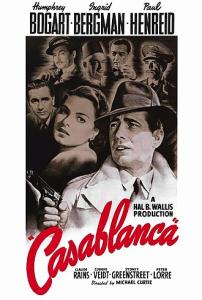
The Song of Bernadette (1943)
The Song of Bernadette is a 1943 American biographical drama film based on the 1941 novel of the same name by Franz Werfel. It stars Jennifer Jones in the title role, which portrays the story of Saint Bernadette Soubirous, who reportedly experienced eighteen visions of the Blessed Virgin Mary from February to July 1858 and was canonized in 1933. The film was directed by Henry King, from a screenplay by George Seaton. Jennifer Jones portrayal of St. Bernadette earned her the Academy Award and Golden Globe for Best Actress. Vincent Price is also in this film. It also won the 1st Golden Globe for best picture.
The novel was extremely popular, spending more than a year on The New York Times Best Seller list and thirteen weeks heading the list. The story was also turned into a Broadway play, which opened at the Belasco Theatre in March 1946. The theatrical release poster by Norman Rockwell
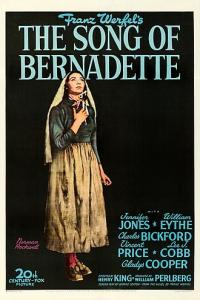
The Yankee Doodle Mouse (1943)
In honor of the U.S. military during WWII, Tom and Jerry do battle in the basement, using household items as war weapons and vehicles.
This Tom and Jerry cartoon won its first Oscar this year and would go on to win another six Oscars, including three in a row over the next three years, from a total of 13 nominations.

- Phantom of the Opera (1943) It was directed by Arthur Lubin, loosely based on Gaston Leroux‘s novel The Phantom of the Opera and its 1925 film adaptation starring Lon Chaney. Produced and distributed by Universal Pictures, the film stars Nelson Eddy, Susanna Foster and Claude Rains. It was composed by Edward Ward. This was the first adaptation of the source material to be filmed entirely in Technicolor, Phantom of the Opera was even more freely adapted than Universal’s silent picture. The film reused Universal’s elaborate replica of the Opéra Garnier interior, which had originally been created for the 1925 film. Despite mixed critical reviews, the film was a box office success. It is also the only classic Universal horror film to win an Oscar, for Art Direction and Cinematography.
- Lassie Come Home (1943) It starred Roddy McDowall and canine actor Pal, in a story about the profound bond between Yorkshire boy Joe Carraclough and his rough collie, Lassie. The film was directed by Fred M. Wilcox from a screenplay by Hugo Butler based upon the 1940 novel Lassie Come-Home by Eric Knight. The film was the first in a series of seven MGM films starring “Lassie.” In 1993, Lassie Come Home was included in the annual selection of 25 motion pictures added to the National Film Registry of the Library of Congress being deemed “culturally, historically, or aesthetically significant” and recommended for preservation. The original film saw a sequel, Son of Lassie in 1945 with five other films following at intervals through the 1940s. The film was nominated for an Academy Award for Best Cinematography, Color and later the character of Lassie received a star on the Hollywood Walk of Fame at 6368 Hollywood Blvd.
nomination - Jack London (1943) It is based on the 1921 book The Book of Jack London by London’s second wife, Charmian London. The film follows scenes from the life of the writer-adventurer Jack London (Michael O’Shea, who somewhat resembled London) who was, among other things, oyster pirate, hobo, sailor, prospector and war correspondent. The film begins and ends with footage from 1943 of the launch of the liberty ship Jack London. It received a nomination for Best Music (Music Score of a Dramatic or Comedy Picture)
- National Velvet (1944) It was directed by Clarence Brown and based on the 1935 novel of the same name by Enid Bagnold. It stars Mickey Rooney, Donald Crisp, Angela Lansbury, Anne Revere, Reginald Owen, and an adolescent Elizabeth Taylor. In 2003, National Velvet was selected for preservation in the United States National Film Registry by the Library of Congress as being “culturally, historically, or aesthetically significant.” In 2006, the film was ranked 24th on the American Film Institute‘s list of most inspirational movies. The film won two Oscars, and was nominated for three others.
Meet Me in St. Louis (1944)
Meet Me in St. Louis is a 1944 American Christmas musical film made by Metro-Goldwyn-Mayer. Divided into a series of seasonal vignettes, starting with Summer 1903, it relates the story of a year in the life of the Smith family in St. Louis leading up to the opening of the Louisiana Purchase Exposition (most commonly referred to as the World’s Fair) in the spring of 1904. The film stars Judy Garland, Margaret O’Brien, Mary Astor, Lucille Bremer, Tom Drake, Leon Ames, Marjorie Main, June Lockhart and Joan Carroll. The film was adapted by Irving Brecher and Fred F. Finklehoffe from a series of short stories by Sally Benson originally published in The New Yorker magazine called “The Kensington Stories”[6] and later in novel form as Meet Me in St. Louis. The film was directed by Vincente Minnelli, who met Garland on the set and later married her. Tony Award-winning designer Lemuel Ayers served as the film’s art director.
Upon its release, Meet Me in St. Louis was both a critical and a commercial success. It became the second-highest-grossing film of 1944, behind only Going My Way, and was also MGM’s most successful musical of the 1940s. In 1994, the film was deemed “culturally, historically, or aesthetically significant” by the Library of Congress and selected for preservation in the United States National Film Registry.
Garland debuted the standards “The Trolley Song“, “The Boy Next Door” and “Have Yourself a Merry Little Christmas“, all written by Hugh Martin and Ralph Blane for the film, and all of which became hits after the film was released. The film’s producer Arthur Freed also wrote and performed one of the songs.
It was nominated for 5 Academy Awards and Margaret O’Brien won the Academy Juvenile Award.
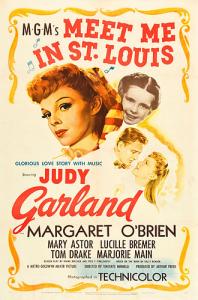
- Gaslight (1944) Gaslight was released theatrically on May 4, 1944, by Metro-Goldwyn-Mayer to critical acclaim, and received seven nominations for the 17th Academy Awards, including for Best Picture, winning two: Best Actress (for Bergman); Best Production Design. In 2019, the film was selected for preservation in the United States National Film Registry by the Library of Congress as being “culturally, historically, or aesthetically significant”.
- Laura (1944) This movie received five nominations for the Academy Awards, including for Best Director, winning for Best Black and White Cinematography. In 1999, Laura was selected for preservation in the United States National Film Registry by the Library of Congress as being “culturally, historically, or aesthetically significant”.
- Lifeboat (1944) The film is directed by Alfred Hitchcock from a story by John Steinbeck. It is set entirely on a lifeboat launched from a freighter torpedoed and sunk by a Nazi U-boat. The first in Hitchcock’s “limited-setting” films, the others being Rope (1948), Dial M for Murder and Rear Window (both 1954), it is the only film Hitchcock made for 20th Century Fox. The film received three Oscar nominations for Best Director, Best Original Story and Best Cinematography – Black and White. Bankhead won the New York Film Critics Circle Award for Best Actress.
- The Adventures of Mark Twain (1944) It was directed by Irving Rapper and starring Fredric March as Samuel Clemens (Mark Twain) and Alexis Smith as Twain’s wife Olivia. Produced by Warner Bros., the film was nominated for three Academy Awards, including that for Best Music for Max Steiner‘s score.
- Irish Eyes Are Smiling (1944) The movie is a musical account of the life of Ernest R. Ball, a gifted composer of many popular Irish songs, including the titular one. The film was nominated for the Academy Award for Best Original Score.
- It Happened Tomorrow (1944) A young turn-of-the-century newspaper man finds he can get hold of the next day’s paper. This brings more problems than fortune, especially as his new girlfriend is part of a phony clairvoyant act. Robert Stolz was nominated for the Academy Award for Best Music, Scoring of a Dramatic or Comedy Picture, while Jack Whitney was nominated for Best Sound, Recording.
- The Princess and the Pirate (1944) Directed by David Butler, and starring Bob Hope and Virginia Mayo. Based on a story by Sy Bartlett, the film is about a princess who travels incognito to elope with her true love instead of marrying the man to whom she is betrothed. On the high seas, her ship is attacked by pirates who plan to kidnap her and hold her for ransom, unaware that she will be rescued by the unlikeliest of knights errant. Produced by Samuel Goldwyn, The Princess and the Pirate received Academy Award nominations for Best Art Direction and Best Music Score.
The Keys of the Kingdom (1944)
The film is based on the 1941 novel The Keys of the Kingdom by A. J. Cronin. The film was adapted by Nunnally Johnson, directed by John M. Stahl, and produced by Joseph L. Mankiewicz. It stars Gregory Peck, Thomas Mitchell, and Vincent Price, and tells the story of the trials and tribulations of a Roman Catholic priest who goes to China to evangelise.
The film was nominated for Academy Awards in the following categories:
- Best Actor in a Leading Role (Gregory Peck)
- Best Art Direction-Interior Decoration, Black-and-White (James Basevi, William S. Darling, Thomas Little, and Frank E. Hughes)
- Best Cinematography, Black-and-White (Arthur C. Miller)
- Best Music, Scoring of a Dramatic or Comedy Picture (Alfred Newman)
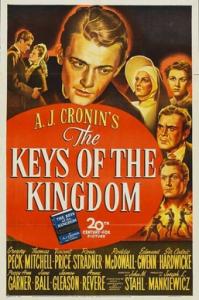
Going My Way (1944)
When young Father O’Malley arrives at St. Dominic’s, old Father Fitzgibbon doesn’t think much of his new assistant.
Going My Way is a 1944 American musical comedy drama film directed by Leo McCarey and starring Bing Crosby and Barry Fitzgerald. Written by Frank Butler and Frank Cavett, based on a story by McCarey, the film is about a new young priest taking over a parish from an established old veteran. Crosby sings five songs[2] with other songs performed onscreen by Metropolitan Opera‘s star mezzo-soprano Risë Stevens and the Robert Mitchell Boys Choir. Going My Way was the highest-grossing picture of 1944, and was nominated for ten Academy Awards, winning seven, including Best Picture. Its success helped to make movie exhibitors choose Crosby as the biggest box-office draw of the year, a record he would hold for the remainder of the 1940s. After World War II, Crosby and McCarey presented a copy of the film to Pope Pius XII at the Vatican.

Going My Way was followed the next year by a sequel,
The Bells of St. Mary’s (1945)
At a big city Catholic school, Father O’Malley and Sister Benedict indulge in friendly rivalry, and succeed in extending the school through the gift of a building.
At the Academy Awards, it won for Best Sound Recording (Stephen Dunn). It was nominated for Best Actor in a Leading Role (Bing Crosby), Best Actress in a Leading Role (Ingrid Bergman), Best Director, Best Film Editing, Best Music, Scoring of a Dramatic or Comedy Picture, Best Music, Song (for Jimmy Van Heusen (music) and Johnny Burke (lyrics) for “Aren’t You Glad You’re You”) and Best Picture.
Bing Crosby’s Academy Award nomination for his portrayal of Father Chuck O’Malley made him the first actor in history to receive two nominations for portraying the same character in different films. This was following the previous year’s nomination anomaly, where Barry Fitzgerald received nominations in both supporting and lead for the same film (as the same character), the prequel Going My Way. While he lost in lead to his co-star Crosby, Fitzgerald won for Best Supporting Actor.
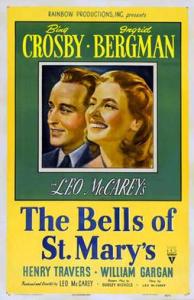
- Anchors Aweigh(1945) It starred Frank Sinatra, Kathryn Grayson, and Gene Kelly, with songs by Jule Styne and Sammy Cahn. Directed by George Sidney, the film also features José Iturbi, Pamela Britton, and Dean Stockwell. The plot concerns two sailors on a four-day shore leave in Hollywood, who meet a young boy and his aunt, an aspiring young singer, and try to help her get an audition with the famed pianist and conductor Iturbi at Metro-Goldwyn-Mayer. In a sequence, Kelly dances with the animated Jerry Mouse from Tom and Jerry. The film was nominated for five Academy Awards, winning one, for best scoring. It received highly positive reviews and became a financial success.
- The Picture of Dorian Gray (1945) It is a supernatural horror–drama film based on Oscar Wilde‘s 1890 novel of the same name. It was nominated for 3 Acadadmy Awards and won for Best Cinematography, Black-and-White.
- A Tree Grows in Brooklyn (1945) Adapted by Tess Slesinger and Frank Davis from the 1943 novel by Betty Smith, the film focuses on an impoverished but aspirational, second-generation Irish-American family living in the Williamsburg neighborhood of Brooklyn, New York, in the early 20th century. Peggy Ann Garner received the Academy Juvenile Award for her performance as Francie Nolan, the adolescent girl at the center of the coming-of-age story. A Tree Grows in Brooklyn was selected for preservation in the United States National Film Registry by the Library of Congress as being “culturally, historically, or aesthetically significant”.
- Wonder Man (1945) Directed by H. Bruce Humberstone and starring Danny Kaye and Virginia Mayo.After being murdered by gangsters, an exuberant nightclub entertainer returns as a ghost to persuade his meek twin brother to help bring his killers to justice. The film won an Academy Award for Best Special Effects at the 18th Academy Awards in 1946, and was also nominated for Best Original Song, Best Musical Score, and Best Sound Recording.
It’s a Wonderful Life (1946)
The film stars James Stewart as George Bailey, a man who has given up his personal dreams to help others in his community and whose thoughts of suicide on Christmas Eve bring about the intervention of his guardian angel, Clarence Odbody. Clarence shows George all the lives he touched and what the world would be like if he had not existed.
Although it was nominated for five Academy Awards, including Best Picture, It’s a Wonderful Life initially received mixed reviews and was unsuccessful at the box office.
It’s a Wonderful Life is now considered to be one of the greatest films of all time and among the best Christmas films. In 1990, It’s a Wonderful Life became one of 25 films selected for preservation in the United States National Film Registry by the Library of Congress for being deemed as “culturally, historically, or aesthetically significant”.

- The Yearling (1946) The film stars: Gregory Peck, Jane Wyman, Claude Jarman Jr., Chill Wills and Forrest Tucker.The story follows a boy named Jody, who adopts a trouble-making young deer. It was nominated for 7 Academy Awards and won 2.
- Anna and the King of Siam (1946) Directed by John Cromwell. An adaptation of the 1944 novel of the same name by Margaret Landon, it was based on the fictionalized diaries of Anna Leonowens, an Anglo-Indian woman who claimed to be British and became governess in the Royal Court of Siam (now modern Thailand) during the 1860s. Darryl F. Zanuck read Landon’s book in galleys and immediately bought the film rights. The story mainly concerns the culture clash of the Imperialist Victorian values of the British Empire with the autocratic rule of Siam’s King Mongkut. The successful film starred Rex Harrison as the king and Irene Dunne as Anna. At the 19th Academy Awards ceremony, the film received two Oscars; for Best Cinematography and Best Art Direction (Lyle R. Wheeler, William S. Darling, Thomas Little, Frank E. Hughes). Also nominated were Bernard Herrmann for the score, the screenwriters and supporting actress Gale Sondergaard. Landon’s novel was later adapted by Rodgers and Hammerstein for their 1951 stage musical The King and I and subsequent 1956 film of the same name. American film director Andy Tennant remade the film in 1999 as Anna and the King with Jodie Foster and Chow Yun-fat.
Song of the South (1946)
Song of the South was directed by Harve Foster and Wilfred Jackson, produced by Walt Disney, and released by RKO Radio Pictures. It is based on the Uncle Remus stories as adapted by Joel Chandler Harris, stars James Baskett in his final film role, and features the voices of Johnny Lee, Baskett, and Nick Stewart. The film takes place in the U.S. state of Georgia during the Reconstruction era, a period of American history after the end of the American Civil War and the abolition of slavery. The story follows seven-year-old Johnny (Bobby Driscoll) who is visiting his grandmother’s (Lucile Watson) plantation for an extended stay. Johnny befriends Uncle Remus (Baskett), an elderly worker on the plantation, and takes joy in hearing his tales about the adventures of Br’er Rabbit (Lee), Br’er Fox, and Br’er Bear (Baskett and Stewart). Johnny learns from the stories how to cope with the challenges he is experiencing while living on the plantation.
The song “Zip-a-Dee-Doo-Dah” won the 1947 Academy Award for Best Original Song and Baskett received an Academy Honorary Award for his performance as Uncle Remus. Since its initial release the film has attracted controversy, with critics characterizing its portrayal of African Americans and plantation life as racist. As a result of the film’s controversial legacy, Disney has not released Song of the South on any home video format in the United States, and the film has never been available on its streaming platform Disney+. Some of the musical and animated sequences have been released through other means, and the full film has seen home video distribution in other countries. The cartoon characters from the film continued to appear in a variety of books, comics, and other Disney media for many decades after the film’s release. The theme park ride Splash Mountain, located at Tokyo Disneyland and formerly located at Disneyland and Magic Kingdom, is based on the film’s animated sequences.
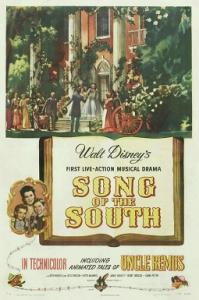
The Bishop’s Wife (1947)
The Bishop’s Wife (also known as Cary and the Bishop’s Wife) is a American Christmas romantic fantasy comedy film directed by Henry Koster, starring Cary Grant, Loretta Young and David Niven. The plot is about an angel who helps a bishop with his problems. The film was adapted by Leonardo Bercovici and Robert E. Sherwood from the 1928 novel of the same name by Robert Nathan.
It was remade in 1996 as The Preacher’s Wife starring Denzel Washington, Whitney Houston, and Courtney B. Vance.
It had 5 Academy Award nominations including Best Picture.
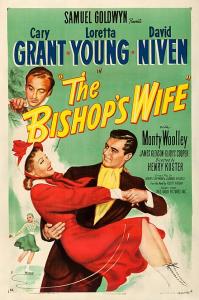
Miracle on 34th Street (1947)
Miracle on 34th Street (initially released as The Big Heart in the United Kingdom) is a 1947 American Christmas comedy-drama film released by 20th Century-Fox, written and directed by George Seaton and based on a story by Valentine Davies. It stars Maureen O’Hara, John Payne, Natalie Wood, and Edmund Gwenn. The story takes place between Thanksgiving and Christmas in New York City, and focuses on the effect of a department store Santa Claus who claims to be the real Santa. The film has become a perennial Christmas favorite.
Miracle on 34th Street won three Academy Awards: Gwenn for Best Actor in a Supporting Role, Valentine Davies for Best Writing, Original Story, and George Seaton for Best Writing, Screenplay. The film was nominated for Best Picture, losing to Gentleman’s Agreement. In 2005, the film was selected for preservation in the United States National Film Registry by the Library of Congress as being “culturally, historically or aesthetically significant”. The Academy Film Archive preserved Miracle on 34th Street in 2009.
Davies also wrote a short novelization of the tale, which was published by Harcourt Brace simultaneously with the film’s release.
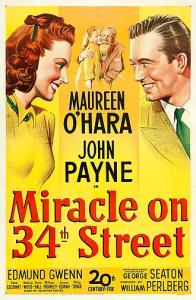
Black Narcissus (1947)
It was directed and produced by Michael Powell and Emeric Pressburger, based on the 1939 novel by Rumer Godden. It stars Deborah Kerr, Sabu, David Farrar, and Flora Robson, and features Esmond Knight, Jean Simmons, and Kathleen Byron.
Set during the final years of British colonial rule in India, the film depicts the growing tensions within a small convent of Anglican sisters who are trying to establish a school and hospital in the old harem of an Indian Raja at the top of an isolated mountain in the Himalayas. The nuns have trouble adapting to the harsh climate and antagonistic population. They come to rely on the help and advice of the Raja’s British agent, a cynical Englishman whose attractiveness and panache become a source of temptation for the sisters.
Black Narcissus received acclaim for its technical mastery, with the cinematographer, Jack Cardiff, winning an Academy Award for Best Cinematography and a Golden Globe Award for Best Cinematography, and Alfred Junge winning an Academy Award for Best Art Direction.
In the United States, the Catholic National Legion of Decency condemned the film as “an affront to religion and religious life” for characterising it as “an escape for the abnormal, the neurotic and the frustrated”. The version of the film originally shown in the United States had scenes depicting flashbacks of Sister Clodagh’s life before becoming a sister edited out at the behest of the Legion of Decency. The 10 cuts to the film, of about 900 feet of film, were supervised by Pressburger, who commented that the cuts were “reasonable, fair and just”, and that he made them to further the film’s distribution, as the only bookings it had while on the “condemned” list were in New York, Los Angeles and San Francisco. After the cuts were made, the Legion of Decency removed the film from the list, and further bookings were possible.
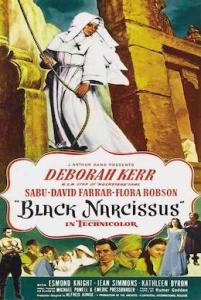
Monsieur Vincent (1947)
The film depicts the life of Vincent de Paul, the 17th-century priest and charity worker. It depicts his struggle to help the poor in the face of disasters, such as the Black Death. It received an honorary Academy Award as the best foreign language film released in the United States in 1948. The Vatican placed it on their 1995 list of films.
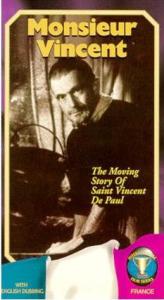
Joan of Arc (1948)
Joan of Arc is a American epic historical drama film directed by Victor Fleming, and starring Ingrid Bergman as the eponymous French religious icon and war heroine. It was produced by Walter Wanger and is based on Maxwell Anderson‘s successful Broadway play Joan of Lorraine, which also starred Bergman, and was adapted for the screen by Anderson himself, in collaboration with Andrew Solt. It is the last film Fleming directed before his death in 1949.
Best Actress Ingrid Bergman Nominated
Best Supporting Actor José Ferrer Nominated
Best Art Direction-Set Decoration (color) Richard Day, Edwin Casey Roberts, Joseph Kish Nominated
Best Cinematography (color) Joseph Valentine, William V. Skall, Winton C. Hoch Won
Best Costume Design (color) Barbara Karinska, Dorothy Jeakins Won
Best Film Editing Frank Sullivan Nominated
Best Score, Dramatic or Comedy Picture Hugo Friedhofer Nominated
Honorary Award* Walter Wanger Won
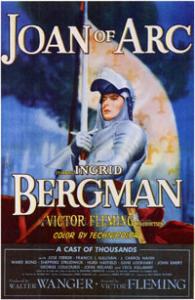
- I Remember Mama (1948) 5 Nominations
- Easter Parade (1948) 1 Nomination
- Sitting Pretty (1948) 1 Nomination
- The Luck of the Irish (1948) 1 Nomination
- The Pirate (1948) 1 Nomination
- The Three Musketeers (1948) 1 Nomination
- Mighty Joe Young (1949) 1 Nomination
- On the Town (1949) 1 Nomination
- The Stratton Story (1949) 1 Nomination
- Samson and Delilah (1949) 5 Nominations
1950’s
- All About Eve (1950) 14 Nomination
- Sunset Boulevard (1950) 11 Nomination
- King Solomon’s Mines (1950) 3 Nomination
- Harvey (1950) 2 Nomination
- Cyrano de Bergerac (1950) 1 Nomination
- Gerald McBoing-Boing (1950) 1 Nomination
The African Queen (1951)
In WWI East Africa, a gin-swilling Canadian riverboat captain is persuaded by a strait-laced English missionary to undertake a trip up a treacherous river and use his boat to attack a German gunship.
The film was directed by John Huston and stars Humphrey Bogart (who won the Academy Award for Best Actor, his only Oscar) and Katharine Hepburn with Robert Morley, Peter Bull, Walter Gotell, Richard Marner and Theodore Bikel.Humphrey Bogart was the last man born in the 19th century to win Best Actor.
The African Queen was selected for preservation in the United States National Film Registry in 1994, and the Library of Congress deemed it “culturally, historically or aesthetically significant.”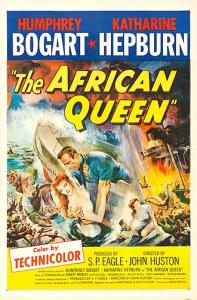
- Quo Vadis (1951)
- David and Bathsheba (1951)
- Too Young to Kiss (1951)
- A Streetcar Named Desire (1951)
- An American in Paris (1951)
- Kon-Tiki (1951)
- Hans Christian Andersen (1952)
- Singin’ in the Rain (1952)
- The Pride of St. Louis (1952)
The Quiet Man (1952)
A retired American boxer returns to the village of his birth in 1920s Ireland, where he falls for a spirited redhead whose brother is contemptuous of their union.
It directed and produced by John Ford, and starring John Wayne, Maureen O’Hara, Victor McLaglen, Barry Fitzgerald, Arthur Shields and Ward Bond. The screenplay by Frank S. Nugent was based on a 1933 Saturday Evening Post short story of the same name by Irish author Maurice Walsh, later published as part of a collection titled The Green Rushes. The film features Winton Hoch‘s lush photography of the Irish countryside and a long, climactic, semi-comic fist fight.
John Ford won the Academy Award for Best Director, his fourth, and Winton Hoch won for Best Cinematography. In 2013, the film was selected for preservation in the United States National Film Registry by the Library of Congress as being “culturally, historically, or aesthetically significant”.
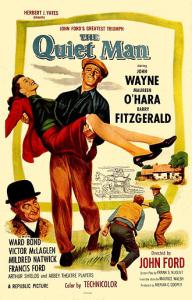
High Noon (1952)
High Noon is a 1952 American Western film produced by Stanley Kramer from a screenplay by Carl Foreman, directed by Fred Zinnemann, and starring Gary Cooper. The plot, which occurs in real time, centers on a town marshal whose sense of duty is tested when he must decide to either face a gang of killers alone, or leave town with his new wife.
Though mired in controversy at the time of its release due to its political themes, the film was nominated for seven Academy Awards and won four (Actor, Editing, Score and Song) as well as four Golden Globe Awards (Actor, Supporting Actress, Score, and Black and White Cinematography).[4] The award-winning score was written by Ukraine-born composer Dimitri Tiomkin.
High Noon was selected by the Library of Congress as one of the first 25 films for preservation in the United States National Film Registry for being “culturally, historically, or aesthetically significant” in 1989.[ An iconic film whose story has been partly or completely repeated in later film productions, its ending in particular has inspired numerous later films, including but not just limited to westerns.
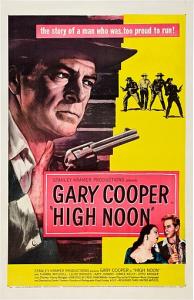
The Miracle of Our Lady of Fatima (1952)
The Miracle of Our Lady of Fatima is a Warner Color feature film made in 1952.It was promoted as a fact-based treatment of the events surrounding the apparitions of Our Lady of Fátima, in Portugal, in 1917.
It stars Susan Whitney as Lúcia dos Santos, Sherry Jackson as Jacinta Marto and Sammy Ogg as Francisco Marto, with Gilbert Roland as a fictional character named Hugo, a kindly but agnostic friend of the three children, who rediscovered his faith in God through the Miracle of the Sun. The musical score by Max Steiner received an Academy Award nomination.
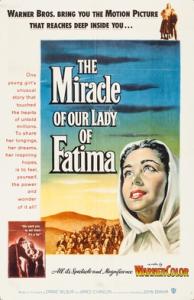
- Roman Holiday (1953)
- Shane (1953)
- Stalag 17 (1953)
- Titanic (1953)
- The 5,000 Fingers of Dr. T. (1953)
- The Caddy (1953)
- Knights of the Round Table (1953)
- Martin Luther (1953)
The Robe (1953)
The Robe is a 1953 American fictional Biblical epic film that tells the story of a Roman military tribune who commands the unit that is responsible for the crucifixion of Jesus. The film was released by 20th Century Fox and was the first film released in the widescreen process CinemaScope. Like other early CinemaScope films, The Robe was shot with Henri Chrétien‘s original Hypergonar anamorphic lenses.
The film was directed by Henry Koster and produced by Frank Ross. The screenplay was adapted from Lloyd C. Douglas‘s 1942 novel by Gina Kaus, Albert Maltz, and Philip Dunne—although Maltz’s place among the blacklisted Hollywood 10 led to his being denied his writing credit for many years. The score was composed by Alfred Newman, and the cinematography was by Leon Shamroy. The film stars Richard Burton, Jean Simmons, Victor Mature and Michael Rennie, and co-stars Jay Robinson, Dean Jagger, Torin Thatcher, Richard Boone, Betta St. John, Jeff Morrow, Ernest Thesiger, and others.
A sequel, Demetrius and the Gladiators (1954), continues from where The Robe ends.
- Wins
- Best Art Direction (Color) – Art Direction: Lyle R. Wheeler, George Davis; Set Decoration: Walter M. Scott, Paul S. Fox
- Best Costume Design (Color) – Charles LeMaire, Emile Santiago
- Nominations
- Best Motion Picture – Producer: Frank Ross
- Best Actor – Richard Burton
- Best Cinematography (Color) – Leon Shamroy
- Wins
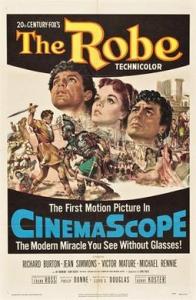
The War of the Worlds (also known in promotional material as H. G. Wells’ The War of the Worlds) is a 1953 American science fiction thriller film directed by Byron Haskin, produced by George Pal, and starring Gene Barry and Ann Robinson. It is the first of several feature film adaptations of H. G. Wells‘ 1898 novel of the same name. The setting is changed from Victorian era England to 1953 Southern California. Earth is suddenly invaded by Martians, and American scientist Doctor Clayton Forrester searches for any weakness to stop them.
The War of the Worlds won the Academy Award for Best Visual Effects and went on to influence other science fiction films. In 2011, it was selected for preservation in the National Film Registry by the United States Library of Congress, who deemed it “culturally, historically, or aesthetically significant”.
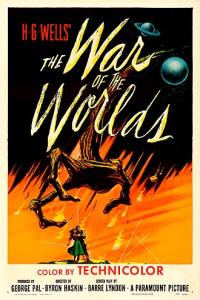
On the Waterfront (1954)
An ex-prize fighter turned New Jersey longshoreman struggles to stand up to his corrupt union bosses, including his older brother, as he starts to connect with the grieving sister of one of the syndicate’s victims.
On the Waterfront was directed by Elia Kazan and written by Budd Schulberg. It stars Marlon Brando, and features Karl Malden, Lee J. Cobb, Rod Steiger, Pat Henning and Eva Marie Saint in her film debut.
It received twelve Academy Award nominations and won eight, including Best Picture, Best Actor for Brando, Best Supporting Actress for Saint, and Best Director for Kazan. In 1997, it was ranked by the American Film Institute as the eighth-greatest American movie of all time; in AFI’s 2007 list, it was ranked 19th. It is Bernstein’s only original film score not adapted from a stage production with songs.
In 1989, On the Waterfront was one of the first 25 films to be deemed “culturally, historically, or aesthetically significant” by the Library of Congress[2] and selected for preservation in the United States National Film Registry.

Father Barry: Some people think the Crucifixion only took place on Calvary. They better wise up! Taking Joey Doyle’s life to stop him from testifying is a crucifixion. And dropping a sling on Kayo Dugan because he was ready to spill his guts tomorrow, that’s a crucifixion. And every time the Mob puts the pressure on a good man, tries to stop him from doing his duty as a citizen, it’s a crucifixion. And anybody who sits around and lets it happen, keeps silent about something he knows that happened, shares the guilt of it just as much as the Roman soldier who pierced the flesh of our Lord to see if he was dead…Boys, this is my church! And if you don’t think Christ is down here on the waterfront, you’ve got another guess coming!
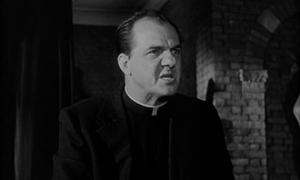
Rear Window (1954)
A bored photographer recovering from a broken leg passes the time by watching his neighbors and begins to suspect one of them of murder.
Rear Window was directed by Alfred Hitchcock and written by John Michael Hayes, based on Cornell Woolrich‘s 1942 short story “It Had to Be Murder“. Originally released by Paramount Pictures, the film stars James Stewart, Grace Kelly, Wendell Corey, Thelma Ritter, and Raymond Burr.
Rear Window is considered by many filmgoers, critics, and scholars to be one of Hitchcock’s best films, as well as one of the greatest films ever made. It received four Academy Award nominations, and was ranked number 42 on AFI’s 100 Years…100 Movies list and number 48 on the 10th-anniversary edition, and in 1997 was added to the United States National Film Registry in the Library of Congress as being “culturally, historically, or aesthetically significant.”
The film was made with a budget of $1 million ($11.7 million in 2024), and grossed $27 million during its initial release ($316 million in 2024)
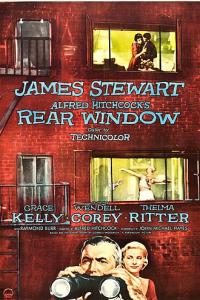
Seven Brides for Seven Brothers (1954)
Seven Brides for Seven Brothers, which is set in Oregon in 1850, is particularly known for Kidd’s unusual choreography, which makes dance numbers out of such mundane frontier pursuits as chopping wood and raising a barn. Film critic Stephanie Zacharek has called the barn-raising sequence in Seven Brides “one of the most rousing dance numbers ever put on screen.”[4] The film was photographed in Ansco Color in the CinemaScope format.
Seven Brides for Seven Brothers won the Academy Award for Best Scoring of a Musical Picture and was nominated for four additional awards, including Best Picture. In 2006, American Film Institute named Seven Brides for Seven Brothers as one of the best American musical films ever made. In 2004, the same year Howard Keel died, Seven Brides for Seven Brothers was selected for preservation in the U.S. National Film Registry of the Library of Congress as being “culturally, historically, or aesthetically significant.”
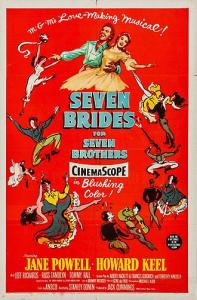
20,000 Leagues Under the Sea (1954)
20,000 Leagues Under the Sea is a American science fiction adventure film directed by Richard Fleischer, from a screenplay by Earl Felton. Adapted from Jules Verne‘s 1870 novel Twenty Thousand Leagues Under the Seas, the film was produced by Walt Disney Productions. It stars Kirk Douglas, James Mason, Paul Lukas, and Peter Lorre. Photographed in Technicolor, the film was one of the first feature-length motion pictures to be filmed in CinemaScope. It was also the first feature-length Disney film to be distributed by Buena Vista Distribution.
20,000 Leagues Under the Sea was a critical and commercial success, being especially remembered for the fight with a giant squid, as well as Mason’s definitive performance as the charismatic anti-hero Captain Nemo. The film won two Academy Awards for its art direction and special effects.

- The Caine Mutiny (1954)
- A Star Is Born (1954)
- Brigadoon (1954)
- The Silver Chalice (1954)
- Them! (1954)
- Rebel Without a Cause (1955)
- A Man Called Peter (1955)
- Mr. Hulot’s Holiday (1955)
- Around the World in 80 Days (1956)
- Giant (1956)
- Anastasia (1956)
- The Red Balloon (1956)
- Friendly Persuasion (1956)
- Seven Samurai (1956)
- Forbidden Planet (1956)
- Time Stood Still (1956)
The Ten Commandments (1956)
The Ten Commandments is a 1956 American epic religious drama film produced, directed, and narrated by Cecil B. DeMille, shot in VistaVision (color by Technicolor), and released by Paramount Pictures. Based on the biblical Book of Exodus and other sources, it dramatizes the story of the life of Moses, an adopted Egyptian prince who becomes the deliverer of his real brethren, the enslaved Hebrews, and thereafter leads the Exodus to Mount Sinai, where he receives, from God, the Ten Commandments. The film stars Charlton Heston in the lead role, Yul Brynner as Rameses, Anne Baxter as Nefretiri, Edward G. Robinson as Dathan, Yvonne De Carlo as Sephora, Debra Paget as Lilia, and John Derek as Joshua; and features Sir Cedric Hardwicke as Seti I, Nina Foch as Bithiah, Martha Scott as Yochabel, Judith Anderson as Memnet, and Vincent Price as Baka, among others.
Filmed on location in Egypt, Mount Sinai, and the Sinai Peninsula, The Ten Commandments was DeMille’s most successful work, his first widescreen film, his fourth biblical production, and his final directorial effort before his death in 1959.

The King and I (1956)
A widow accepts a job as a live-in governess to the King of Siam’s children.
The King and I is a 1956 American musical film made by 20th Century-Fox, directed by Walter Lang and produced by Charles Brackett and Darryl F. Zanuck. The screenplay by Ernest Lehman is based on the 1951 Rodgers and Hammerstein musical The King and I, which is itself based on the 1944 novel Anna and the King of Siam by Margaret Landon. That novel in turn was based on memoirs written by Anna Leonowens, who became school teacher to the children of King Mongkut of Siam in the early 1860s. Leonowens’ stories were autobiographical, although various elements of them have been called into question. The film stars Deborah Kerr and Yul Brynner.
The film was a critical and commercial success and was nominated for 9 Oscars and won 5, including Best Actor for Brynner.
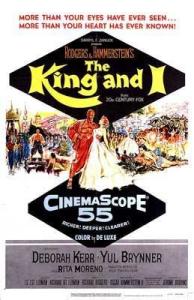
Magoo’s Puddle Jumper (1956)
The cartoon follows the misadventures of the myopic Mr. Magoo alongside nephew Waldo as he drives a new electric car into the ocean.
Magoo’s Puddle Jumper is a animated short produced by UPA for Columbia Pictures. Directed by Pete Burness and produced by Stephen Bosustow, Magoo’s Puddle Jumper won the 1957 Oscar for Short Subjects (Cartoons).
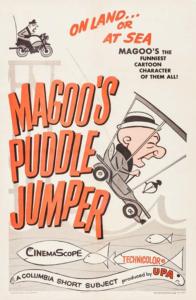
The Bridge on the River Kwai (1957)
British POWs are forced to build a railway bridge across the river Kwai for their Japanese captors in occupied Burma, not knowing that the allied forces are planning a daring commando raid through the jungle to destroy it.
The Bridge on the River Kwai is now widely recognized as one of the greatest films ever made. It was the highest-grossing film of 1957 and received overwhelmingly positive reviews from critics. The film won seven Academy Awards (including Best Picture) at the 30th Academy Awards. In 1997, the film was deemed “culturally, historically, or aesthetically significant” and selected for preservation in the National Film Registry by the United States Library of Congress.
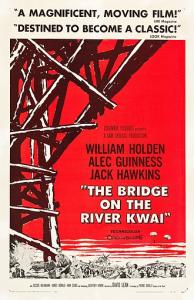
12 Angry Men (1957)
12 Angry Men is a 1957 American legal drama film directed by Sidney Lumet in his feature directorial debut, adapted by Reginald Rose from his 1954 teleplay. A critique of the American jury system during the McCarthy Era, the film tells the story of a jury of twelve men as they deliberate the conviction or acquittal of a teenager charged with murder on the basis of reasonable doubt; disagreement and conflict among the jurors forces them to question their morals and values. It stars an ensemble cast, featuring Henry Fonda (who also produced the film with Rose), Lee J. Cobb, Ed Begley, E. G. Marshall, and Jack Warden.
An independent production distributed by United Artists, 12 Angry Men received acclaim from critics, despite a lukewarm box-office performance. At the 30th Academy Awards, it was nominated for Best Picture, Best Director and Best Screenplay. It is regarded by many as one of the greatest films ever made.
In 2007, it was selected for preservation in the United States National Film Registry by the Library of Congress as being “culturally, historically or aesthetically significant”. Additionally, it was selected as the second-best courtroom drama ever (after 1962’s To Kill a Mockingbird) by the American Film Institute for their AFI’s 10 Top 10 list.
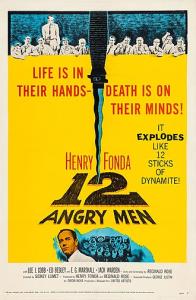
- Heaven Knows, Mr. Allison (1957)
- Witness for the Prosecution (1957)
- The Spirit of St. Louis (1957)
- Vertigo (1958)
- The Brothers Karamazov (1958)
Knighty Knight Bugs (1958)
Knighty Knight Bugs is a Warner Bros. Looney Tunes cartoon directed by Friz Freleng. The short was released on August 23, 1958, and stars Bugs Bunny and Yosemite Sam.
Knighty Knight Bugs is the only Bugs Bunny cartoon to win an Academy Award for Best Animated Short Film, which was awarded in 1959. The short was later included in the 1981 compilation film The Looney, Looney, Looney Bugs Bunny Movie. The cartoon’s title is a pun on the phrase “Nighty Night”
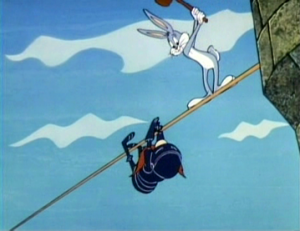
The Inn of the Sixth Happiness (1958)
The Inn of the Sixth Happiness is a 1958 20th Century Fox film loosely based on the story of Gladys Aylward, a British woman who became a missionary in China during the Second Sino-Japanese War. Directed by Mark Robson, who received a nomination for the Academy Award for Best Director, the film stars Ingrid Bergman as Aylward and Curt Jürgens as her love interest, Captain Lin Nan, a Chinese Army officer with a Dutch father. Robert Donat, who played the mandarin of the town in which Aylward lived, died before the film was released. The musical score was composed and conducted by Malcolm Arnold. The cinematography was by Freddie Young.
The film was shot in Snowdonia, North Wales. Most of the children in the film were ethnic Chinese children from Liverpool, home to the oldest Chinese community in Europe.
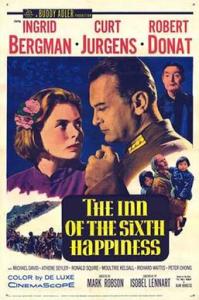
Ben-Hur (1959)
A Jewish prince is betrayed and sent into slavery by a Roman friend in 1st-century Jerusalem, but it’s not long before he regains his freedom and comes back for revenge.
It directed by William Wyler, produced by Sam Zimbalist, and starring Charlton Heston as the title character. A remake of the 1925 silent film with a similar title, it was adapted from Lew Wallace‘s 1880 novel Ben-Hur: A Tale of the Christ. Ben-Hur had the largest budget ($15.175 million), as well as the largest sets built, of any film produced at the time.
It was the fastest-grossing as well as the highest-grossing film of 1959, becoming the second highest-grossing film in history at the time, after Gone with the Wind. It won a record eleven Academy Awards, including Best Picture, Best Director (Wyler), Best Actor in a Leading Role (Heston), Best Actor in a Supporting Role (Griffith), and Best Cinematography – Color (Surtees); it also won Golden Globe Awards for Best Motion Picture – Drama, Best Director, and Best Supporting Actor – Motion Picture for Stephen Boyd. In 1998, the American Film Institute named it the 72nd best American film and the second best American epic film in the AFI’s 10 Top 10. In 2004, the National Film Preservation Board selected Ben-Hur for preservation by the National Film Registry of the Library of Congress for being “culturally, historically, or aesthetically significant”.
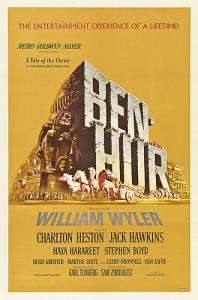
The Nun’s Story (1959)
After leaving a wealthy Belgian family to become a nun, Sister Luke struggles with her devotion to her vows during crisis, disappointment, and World War II.
The film is a relatively faithful adaptation of the novel, which was based on the life of Belgian nun Marie Louise Habets. Latter portions of the film were shot on location in the Belgian Congo and feature Finch as a cynical but caring surgeon. The film was a financial success and was nominated for eight Academy Awards, including Best Picture and Best Actress for Hepburn.
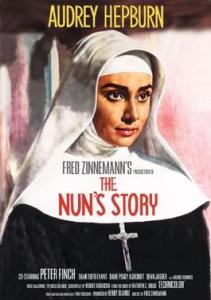
The Diary of Anne Frank (1959)
The Diary of Anne Frank is a 1959 American biographical drama film based on the Pulitzer Prize-winning 1955 play of the same name, which was in turn based on the posthumously published diary of Anne Frank, a German-born Jewish girl who lived in hiding in Amsterdam with her family during World War II. It was directed by George Stevens, a Hollywood filmmaker previously involved with capturing evidence of concentration camps during the war, with a screenplay by Frances Goodrich and Albert Hackett. It is the first film version of both the play and the original story, and features three members of the original Broadway cast.
Many of Frank’s writings to her diary were addressed as “Dear Kitty”. It was published after the end of the war by her father, Otto Frank (played in the film by Joseph Schildkraut, who was also Jewish). His entire family had been murdered in the Holocaust. The interiors were shot in Los Angeles on a sound stage duplicate of the Amsterdam factory, with exteriors filmed at the actual building.
The film was positively received by critics, currently holding a 81% critics rating on Rotten Tomatoes. It won three Academy Awards in 1960, including Best Supporting Actress for Shelley Winters. Shelley Winters later donated her Oscar to the Anne Frank Museum. In 2006, it was honored as the eighteenth most inspiring American film on the list AFI’s 100 Years…100 Cheers.
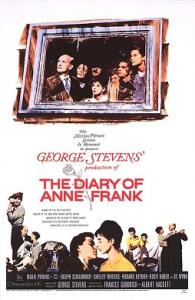
- Some Like It Hot (1959)
- Journey to the Center of the Earth (1959)
- North by Northwest (1959)
- The Big Fisherman (1959)
- Noah’s Ark (1959)
1960’s
The Time Machine (1960)
The Time Machine (also marketed as H. G. Wells’ The Time Machine) is a 1960 American period post-apocalyptic science fiction film based on the 1895 novella of the same name by H. G. Wells. It was produced and directed by George Pal, and stars Rod Taylor, Yvette Mimieux, and Alan Young. The story is set in Victorian England and follows an inventor who constructs a machine that enables him to travel into the distant future. Once there, he discovers that mankind’s descendants have divided into two species, the passive, childlike, and vegetarian Eloi and the underground-dwelling Morlocks, who feed on the Eloi.
The film was originally released on August 17, 1960, and was distributed by Metro-Goldwyn-Mayer. It received the Academy Award for Best Special Effects[5] for its time-lapse photographic effects, which show the world changing rapidly as the time traveler journeys into the future.
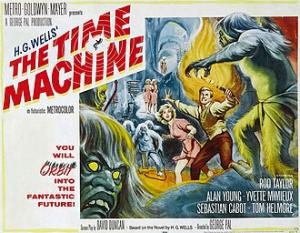
- Spartacus (1960)
- Elmer Gantry (1960)
- Inherit the Wind (1960)
- Psycho (1960)
- Pollyanna (1960)
- Judgment at Nuremberg (1961)
- The Parent Trap (1961)
West Side Story (1961)
Two youngsters from rival New York City gangs fall in love, but tensions between their respective friends build toward tragedy.
WSS is a 1961 American musical romantic drama film directed by Robert Wise and Jerome Robbins, written by Ernest Lehman, and produced by Wise. The film is an adaptation of the 1957 Broadway musical of the same title, which in turn was inspired by Shakespeare‘s play Romeo and Juliet. It stars Natalie Wood, Richard Beymer, Russ Tamblyn, Rita Moreno, and George Chakiris and was photographed by Daniel L. Fapp in Super Panavision 70. The music was composed by Leonard Bernstein, with lyrics by Stephen Sondheim.
Released on October 18, 1961, through United Artists, the film received praise from critics and viewers, and became the highest-grossing film of 1961. It was nominated for 11 Academy Awards and won 10, including Best Picture (in addition to a special award for Robbins), becoming the record holder for the most wins for a musical. West Side Story is regarded as one of the greatest musical films of all time. The film was designated as being “culturally, historically, or aesthetically significant” by the Library of Congress and was selected for preservation in the United States National Film Registry in 1997. A second film adaptation by Steven Spielberg was released in December 2021.
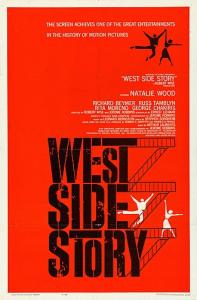
The Absent-Minded Professor (1961)
The Absent-Minded Professor is a 1961 American science fiction comedy film directed by Robert Stevenson and produced by Walt Disney Productions. It is based on the 1943 short story “A Situation of Gravity” (May 22, 1943 Liberty) by Samuel W. Taylor. The title character was based in part on Hubert Alyea, a professor emeritus of chemistry at Princeton University, who was known as “Dr. Boom” for his explosive demonstrations. The film stars Fred MacMurray as Professor Ned Brainard, alongside Nancy Olson, Keenan Wynn, Tommy Kirk, Leon Ames, Elliott Reid, and Edward Andrews. The plot follows Brainard as he invents a substance that defies gravity, which he later exploits through various means.
Released on March 16, 1961, the film was a box office success, and two years later became the first Disney film to have a sequel, Son of Flubber (1963). It was one of the first Disney films to be colorized (for the 1986 VHS release), and, along with The Shaggy Dog (1959) and Son of Flubber, is one of Disney’s few black-and-white films to be produced after 1941. A remake titled Flubber with Robin Williams was released in 1997.
The special effects were created by Robert A. Mattey and Eustace Lycett, who were nominated for an Academy Award, and included the sodium screen matte process, as well as miniatures and wire-supported mockups. The film’s “Medfield Fight Song” was written by Richard M. and Robert B. Sherman, their first song for a Disney feature.

35th Academy Awards
- The Music Man(1962)
- The Wonderful World of the Brothers Grimm (1962)
- The Longest Day (1962)
- Lawrence of Arabia (1962)
The Miracle Worker (1962)
The Miracle Worker is a 1962 American biographical film about Anne Sullivan, blind tutor to Helen Keller, directed by Arthur Penn. The screenplay by William Gibson is based on his 1959 play of the same title, which originated as a 1957 broadcast of the television anthology series Playhouse 90. Gibson’s secondary source material was The Story of My Life, the 1903 autobiography of Helen Keller.
The film went on to be an instant critical success and a moderate commercial success. The film was nominated for five Academy Awards, including Best Director for Arthur Penn, and won two awards, Best Actress for Anne Bancroft and Best Supporting Actress for Patty Duke, the latter of whom, at age 16, became the youngest competitive Oscar winner at the time.
In 2024, the film was selected for preservation in the United States National Film Registry by the Library of Congress as being “culturally, historically, or aesthetically significant”.

To Kill a Mockingbird (1962)
To Kill a Mockingbird is a 1962 American coming-of-age legal drama crime film directed by Robert Mulligan starring Gregory Peck and Mary Badham, with Phillip Alford, John Megna, Frank Overton, James Anderson, and Brock Peters in supporting roles. It marked the film debut of Robert Duvall, William Windom, and Alice Ghostley. Adapted by Horton Foote, from Harper Lee‘s 1960 Pulitzer Prize–winning novel, it follows a lawyer (Peck) in Depression-era Alabama defending a black man (Peters) charged with rape while educating his children (Badham and Alford) against prejudice.
It gained overwhelmingly positive reception )
rom both the critics and the public; a box-office success, it earned more than six times its budget. The film won three Academy Awards, including Best Actor for Peck and Best Adapted Screenplay for Foote, and was nominated for eight, including Best Picture, Best Director, and Best Supporting Actress for Badham.
In 1995, the film was selected by the Library of Congress for preservation in the National Film Registry as “culturally, historically, or aesthetically significant”. In 2003, the American Film Institute named Atticus Finch the greatest movie hero of the 20th century. In 2007, the film ranked twenty-fifth on the AFI’s 10th anniversary list of the greatest American movies of all time. In 2008, the film ranked first on the AFI’s list of the ten greatest courtroom dramas. In 2020, the British Film Institute included it in their list of the 50 films you should see by the age of 15. The film was restored and released on Blu-ray and DVD in 2012, as part of the 100th anniversary of Universal Pictures. It is considered to be one of the greatest movies ever made.
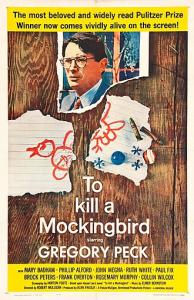
36th Academy Awards
It’s a Mad, Mad, Mad, Mad World (1963)
The film, starring Spencer Tracy with an all-star cast composed largely of comedians, is about the madcap pursuit of a suitcase full of stolen cash by a colorful group of strangers. It premiered on November 7, 1963. The principal cast features Edie Adams, Milton Berle, Sid Caesar, Buddy Hackett, Ethel Merman, Dorothy Provine, Mickey Rooney, Dick Shawn, Phil Silvers, Terry-Thomas, and Jonathan Winters.It was nominated for six Academy Awards, winning for Best Sound Editing, and two Golden Globe Awards. It has cameos by Jim Backus, Peter Falk, Buster Keaton, The Three Stooges, Don Knotts, Jack Benny, and Jerry Lewis.

- Bye Bye Birdie (1963)
- The Birds (1963)
- Lilies of the Field (1963)
- My Fair Lady (1964)
- Beckett (1964)
- Gold Finger (1964)
- Dr. Strangelove or: How I Learned to Stop Worrying and Love the Bomb (1964)
- A Hard Day’s Night (1964)
- The Pink Panther (1964)
- The Gospel According to St. Matthew (1964)
Mary Poppins (1964)
Mary Poppins is a 1964 American live-action/animated hybrid musical fantasy comedy film directed by Robert Stevenson and produced by Walt Disney, with songs written and composed by the Sherman Brothers. The screenplay is by Bill Walsh and Don DaGradi, based on P. L. Travers‘s book series Mary Poppins. The film, which combines live-action and animation, stars Julie Andrews in her feature film debut as Mary Poppins, who visits a dysfunctional family in London and employs her unique brand of lifestyle to improve the family’s dynamic. Dick Van Dyke, David Tomlinson, and Glynis Johns are featured in supporting roles. The film was shot entirely at the Walt Disney Studios in Burbank, California, using painted London background scenes.
Mary Poppins was released on August 27, 1964, to critical acclaim and commercial success, earning $44 million in theatrical rentals in its original run. It became the highest-grossing film of 1964 in the United States, and at the time of its release became Disney’s highest-grossing film. During its theatrical lifetime, it grossed over $103 million worldwide. It received a total of thirteen Academy Award nominations—a record for any film released by Walt Disney Studios—including Best Picture, and won five: Best Actress for Andrews, Best Film Editing, Best Original Music Score, Best Visual Effects, and Best Original Song for “Chim Chim Cher-ee“. It is considered Walt Disney’s crowning live-action achievement and is the only one of his films to earn a Best Picture nomination during his lifetime. In 2013, it was selected for preservation in the United States National Film Registry by the Library of Congress as being “culturally, historically, or aesthetically significant.”
A biographical drama based on the making of the film, Saving Mr. Banks, was released on October 20, 2013. A sequel, Mary Poppins Returns, was released on December 19, 2018.
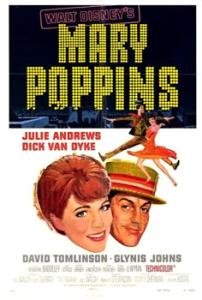
The Sound of Music (1965)
The Sound of Music is a 1965 American musical drama film produced and directed by Robert Wise from a screenplay written by Ernest Lehman, and starring Julie Andrews and Christopher Plummer, with Richard Haydn, Peggy Wood, Charmian Carr, and Eleanor Parker. The film is an adaptation of the 1959 stage musical composed by Richard Rodgers, with lyrics by Oscar Hammerstein II and a book by Lindsay and Crouse. It is based on the 1949 memoir The Story of the Trapp Family Singers by Maria von Trapp and is set in Salzburg, Austria. It is a fictional retelling of her experiences as governess to seven children, her eventual marriage with their father Captain Georg von Trapp, and their escape during the Anschluss in 1938.
The Sound of Music had become the highest-grossing film of all-time, surpassing Gone with the Wind, and it held that distinction for five years. The film was popular throughout the world, breaking previous box-office records in 29 countries. It had an initial theatrical release that lasted four and a half years and two successful re-releases. It sold 283 million admissions worldwide and earned a total worldwide gross of $286 million.
The Sound of Music received five Academy Awards, including Best Picture and Best Director. The film also received Golden Globe Awards for Best Motion Picture and Best Actress, the Directors Guild of America Award for Outstanding Directorial Achievement, and the Writers Guild of America Award for Best Written American Musical. Since its original release, the film is widely regarded as one of the greatest films of all time. In 1998, the American Film Institute (AFI) listed The Sound of Music as the 55th greatest American film of all time, and the fourth-greatest film musical. In 2001, the United States Library of Congress selected the film for preservation in the National Film Registry, finding it “culturally, historically, or aesthetically significant”.
The Sound of Music was the first Best Picture winner without a screenwriting nomination since Hamlet, and would be the last until Titanic at the 70th Academy Awards.
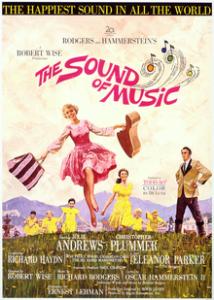
- The Agony and the Ecstasy (1965)
- The Greatest Story Ever Told (1965)
- The Flight of the Phoenix (1965)
- Born Free (1966)
- The Bible: In the Beginning… (1966)
- The Singing Nun (1966)
A Man for All Seasons (1966)
A Man for All Seasons is a 1966 British historical drama film directed and produced by Fred Zinnemann, adapted by Robert Bolt from his play of the same name. It depicts the final years of Sir Thomas More, the 16th-century Lord Chancellor of England who refused both to sign a letter asking Pope Clement VII to annul Henry VIII of England’s marriage to Catherine of Aragon and to take an Oath of Supremacy declaring Henry Supreme Head of the Church of England.
Paul Scofield, who had played More in the West End stage premiere, also took the role in the film, starring alongside Wendy Hiller, Robert Shaw, Susannah York, and Orson Welles. Also appearing are Nigel Davenport, Leo McKern, Corin Redgrave, Vanessa Redgrave and, in one of his earliest screen roles, John Hurt. The film was released by Columbia Pictures on 12 December 1966.
A Man for All Seasons was a critical and box-office success. It won the Academy Award for Best Picture at the 39th Academy Awards, while the cast and crew won another five, including Best Director for Zinnemann and Best Actor for Scofield. It also won the Golden Globe Award for Best Motion Picture – Drama and the BAFTA Awards for Best Film and Best British Film. In 1999, the British Film Institute named it the 43rd greatest British film of all time.
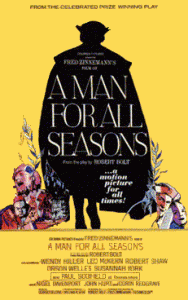
Fantastic Voyage (1966)
Fantastic Voyage is a 1966 American science fiction adventure film directed by Richard Fleischer and written by Harry Kleiner, based on a story by Otto Klement and Jerome Bixby. The film is about a submarine crew who is shrunk to microscopic size and venture into the body of an injured scientist to repair damage to his brain. In adapting the story for his script, Kleiner abandoned all but the concept of miniaturization and added a Cold War element. The film starred Stephen Boyd, Raquel Welch, Edmond O’Brien, Donald Pleasence, and Arthur Kennedy.
Bantam Books obtained the rights for a paperback novelization based on the screenplay and approached Isaac Asimov to write it. Because the novelization was released six months before the movie, many people mistakenly believed that the film was based on Asimov’s book. Its modern and imaginative production design received five nominations at the 39th Academy Awards mostly in technical departments, winning for Best Visual Effects and Best Art Direction in Color.
The movie used the concept of miniaturization in science fiction along with The Incredible Shrinking Man and inspired an animated television series of the same name.
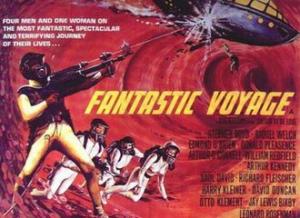
- Doctor Dolittle (1967)
- The Graduate (1967)
- Bonnie and Clyde (1967)
- Cool Hand Luke (1967)
- Guess Who’s Coming to Dinner (1967)
- In the Heat of the Night (1967)
- Wait Until Dark (1967)
- Oliver (1968)
- 2001: A Space Odyssey (1968)
- The Producers (1968)
- Bullitt (1968)
- Rosemary’s Baby (1968)
- The Odd Couple (1968)
- The Shoes of the Fisherman (1968)
- Chitty Chitty Bang Bang (1968)
Planet of the Apes (1968)
Planet of the Apes is a American science fiction film directed by Franklin J. Schaffner from a screenplay by Michael Wilson and Rod Serling, loosely based on the 1963 novel by Pierre Boulle. The film stars Charlton Heston, Roddy McDowall, Kim Hunter, Maurice Evans, James Whitmore, James Daly, and Linda Harrison. In the film, an astronaut crew crash-lands on a strange planet in the distant future. Although the planet appears desolate at first, the surviving crew members stumble upon a society in which apes have evolved into creatures with human-like intelligence and speech. The apes have assumed the role of the dominant species and humans are mute primitives wearing animal skins.
It was nominated for Best Costume Design and Best Original Score at the 41st Academy Awards, and winning an honorary Academy Award for Chambers. In 2001, Planet of the Apes was selected for preservation in the United States National Film Registry by the Library of Congress as being “culturally, historically, or aesthetically significant”.
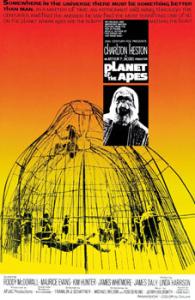
Hello, Dolly! (1969)
Hello, Dolly! is a 1969 American musical romantic comedy film based on the 1964 Broadway production of the same name, which was based on Thornton Wilder‘s play The Matchmaker. Directed by Gene Kelly and written and produced by Ernest Lehman, the film stars Barbra Streisand, Walter Matthau, Michael Crawford, Danny Lockin, Tommy Tune, Fritz Feld, Marianne McAndrew, E. J. Peaker and Louis Armstrong (whose recording of the title tune had been a number-one hit in May 1964).[2]
The film follows the story of Dolly Levi, a strong-willed matchmaker who travels to Yonkers, New York, to find a match for the miserly “well-known unmarried half-a-millionaire” Horace Vandergelder. In doing so, she convinces his niece, his niece’s intended, and Horace’s two clerks to travel to New York City.
Released on December 16, 1969, by 20th Century-Fox, the film won three Academy Awards: for Best Art Direction, Best Score of a Musical Picture and Best Sound, and was nominated for four other Academy Awards, including Best Picture. Although the film eventually broke even financially, it was not a contemporary commercial success.
Songs and footage from the scenes “Put on Your Sunday Clothes” and “It Only Takes a Moment”, as well as still images from the film in general, were prominently featured in the 2008 Disney–Pixar film WALL-E. In the movie, WALL-E watches the footage from an old Betamax tape and learns about the concept of love from the film.
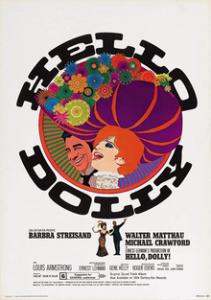
- Midnight Cowboy (1969)
- A Boy Named Charlie Brown (1969)
- Butch Cassidy and the Sundance Kid (1969)
- True Grit (1969)
- Goodbye, Mr. Chips (1969)
- The Wild Bunch (1969)
- Patton (1969)
- Airport (1970)
- M*A*S*H (1970)
- Tora! Tora! Tora! (1970)
- Woodstock (1970)
- Scrooge (1970)
- The French Connection (1971)
- Bedknobs and Broomsticks (1971)
- A Clockwork Orange (1971)
- Willy Wonka & the Chocolate Factory (1971)
Fiddler on the Roof (1971)
Fiddler on the Roof is a 1971 American period musical film produced and directed by Norman Jewison from a screenplay written by Joseph Stein, based on the stage musical by Stein, Jerry Bock, and Sheldon Harnick, which premiered on Broadway in 1964. Set in early 20th-century Imperial Russia, the film centers on Tevye (Chaim Topol), a poor Jewish milkman who is faced with the challenge of marrying off his five daughters amidst the growing tension in his shtetl. The cast also features Norma Crane, Leonard Frey, Molly Picon, Paul Mann, Rosalind Harris, Michèle Marsh, Neva Small and Paul Michael Glaser. The musical score, composed by Bock with lyrics by Harnick, was adapted and conducted by John Williams.
Filmed at Pinewood Studios in England and on-location in SR Croatia, Fiddler on the Roof was theatrically released on November 3, 1971, by United Artists to critical and commercial success. Reviewers praised Jewison’s direction, the screenplay, and the performances of the cast, while the film grossed $83.3 million worldwide on a $9 million budget, becoming the highest-grossing film of 1971.
The film received a leading eight nominations at the 44th Academy Awards, including for Best Picture and Best Director, and won three: Best Score Adaptation (Williams), Best Cinematography (Oswald Morris) and Best Sound (Gordon K. McCallum, David Hildyard). The film also won two Golden Globes: Best Motion Picture – Musical or Comedy and Best Actor in a Motion Picture – Musical or Comedy for Topol.
The film has continued to receive acclaim since its release and is often considered to be one of the greatest musical films of all time. An independently produced documentary about the making of the film, titled Fiddler’s Journey to the Big Screen, was released in 2022.A remake of the film, directed by Thomas Kail, is currently in development.
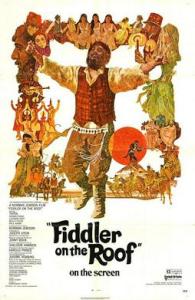
The Godfather is a 1972 American epic crime film directed by Francis Ford Coppola, who co-wrote the screenplay with Mario Puzo, based on Puzo’s best-selling 1969 novel. The Godfather is regarded as one of the greatest and most influential films ever made, as well as a landmark of the gangster genre. The film stars an ensemble cast including Marlon Brando, Al Pacino, James Caan, Richard Castellano, Robert Duvall, Sterling Hayden, John Marley, Richard Conte and Diane Keaton. It is the first installment in The Godfather trilogy, chronicling the Corleone family under patriarch Vito Corleone (Brando) and the transformation of his youngest son, Michael Corleone (Pacino), from reluctant family outsider to ruthless mafia boss.
At the 45th Academy Awards, the film won Best Picture, Best Actor (Brando) and Best Adapted Screenplay (for Puzo and Coppola). In addition, the seven other Oscar nominations included Pacino, Caan and Duvall, all for Best Supporting Actor, and Coppola for Best Director.
The Godfather was selected for preservation in the U.S. National Film Registry of the Library of Congress in 1990, being deemed “culturally, historically, or aesthetically significant” and is ranked the second-greatest film in American cinema (behind Citizen Kane) by the American Film Institute. It was followed by sequels The Godfather Part II (1974) and The Godfather Part III (1990).
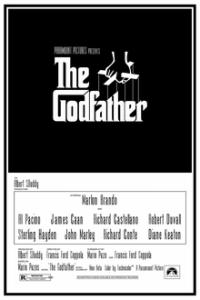
- The Poseidon Adventure (1972)
- A Christmas Carol (1972)
Norman Rockwell’s World… An American Dream (1972)
Norman Rockwell’s World… An American Dream is a 1972 short documentary film about artist Norman Rockwell produced by Richard Barclay and directed by Robert Deubel. The film won an Oscar at the 45th Academy Awards, held in 1973, for Best Short Subject. Barclay, being the producer, was the recipient of the Oscar.
With commentary by Rockwell himself, it examines the vision and essence of the artist through still photos, archival film footage and paintings to capture the hopes, dreams and minimalism of the American people.
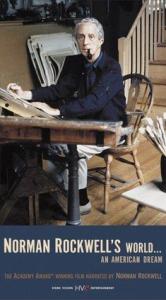
The Exorcist (1973)
The Exorcist is a 1973 American supernatural horror film directed by William Friedkin from a screenplay by William Peter Blatty, based on his 1971 novel. The film stars Ellen Burstyn, Max von Sydow, Jason Miller, and Linda Blair, and follows the demonic possession of a young girl and the attempt to rescue her through an exorcism by two Catholic priests.
The cultural conversation around the film helped it become the first horror film to be nominated for the Academy Award for Best Picture, as well as nine others. Blatty won Best Adapted Screenplay, while the sound engineers took Best Sound. It has had several sequels and was the highest-grossing R-rated horror film (unadjusted for inflation) until 2017’s It. The Exorcist significantly influenced pop culture, and several publications regard it as one of the greatest films ever made. In 2010, the Library of Congress selected the film for preservation in the United States National Film Registry as being “culturally, historically, or aesthetically significant”.

- The Sting (1973)
- American Graffiti (1973)
- Brother Sun, Sister Moon (1973)
- Jesus Christ Superstar (1973)
The Towering Inferno (1974)
The Towering Inferno is a American disaster film directed by John Guillermin and produced by Irwin Allen,[5] featuring an ensemble cast led by Paul Newman and Steve McQueen. It was adapted by Stirling Silliphant from the novels The Tower by Richard Martin Stern and The Glass Inferno by Thomas N. Scortia and Frank M. Robinson. In addition to McQueen and Newman, the cast includes William Holden, Faye Dunaway, Fred Astaire, Susan Blakely, Richard Chamberlain, O. J. Simpson, Robert Vaughn, Robert Wagner, Susan Flannery, Gregory Sierra, Dabney Coleman and Jennifer Jones in her final role.
The Towering Inferno was released theatrically December 16, 1974. The film received generally positive reviews from critics, and earned around $203.3 million, making it the highest-grossing film of 1974. It was nominated for eight Academy Awards, including Best Picture, winning three: Best Song, Best Cinematography and Best Editing.
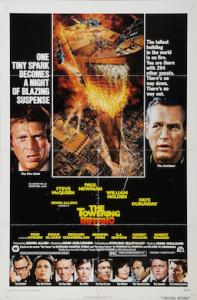
- Earthquake (1974)
- Blazing Saddles (1974)
- Young Frankenstein (1974)
- Benji (1974)
One Flew Over the Cuckoo’s Nest (1975)
In the Fall of 1963, a Korean War veteran and criminal pleads insanity and is admitted to a mental institution, where he rallies up the scared patients against the tyrannical nurse.
One Flew Over the Cuckoo’s Nest is a American psychological comedy-drama film directed by Miloš Forman, based on the novel by Ken Kesey. The film stars Jack Nicholson as a new patient at a mental institution and Louise Fletcher as the domineering head nurse. Will Sampson, Danny DeVito, Sydney Lassick, William Redfield, Christopher Lloyd and Brad Dourif play supporting roles, with the latter two making their feature film debuts.
One Flew Over the Cuckoo’s Nest received critical acclaim, and is considered by critics and audiences to be one of the greatest films ever made. It is the second of three films to win all five major Academy Awards (Best Picture, Best Actor, Best Actress, Director, and Screenplay) following It Happened One Night (1934), and preceding 1991’s The Silence of the Lambs.

Jaws (1975)
Jaws is a 1975 American thriller film directed by Steven Spielberg, based on the 1974 novel by Peter Benchley. It stars Roy Scheider as police chief Martin Brody, who, with the help of a marine biologist (Richard Dreyfuss) and a professional shark hunter (Robert Shaw), hunts a man-eating great white shark that attacks beachgoers at a summer resort town. Murray Hamilton plays the mayor, and Lorraine Gary portrays Brody’s wife. The screenplay is credited to Benchley, who wrote the first drafts, and actor-writer Carl Gottlieb, who rewrote the script during principal photography.
Jaws won three Academy Awards, those being for Best Film Editing, Best Original Dramatic Score, and Best Sound (Robert Hoyt, Roger Heman, Earl Madery, and John Carter). It was also nominated for Best Picture, losing to One Flew Over the Cuckoo’s Nest.[184] Spielberg greatly resented the fact that he was not nominated for Best Director.
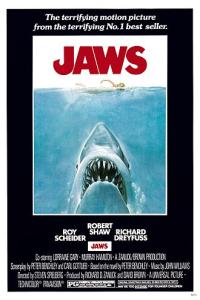
- Network (1976)
- All the President’s Men (1976)
- Bound for Glory (1976)
- A Star is Born (1976)
- The Omen (1976)
- Carrie (1976)
- King Kong (1976)
- Bugsy Malone (1976)
- The Pink Panther Strikes Again (1976)
- The Shootist (1976)
Rocky (1976)
Rocky is a 1976 American independent sports drama film directed by John G. Avildsen and written by and starring Sylvester Stallone. It is the first installment in the Rocky franchise and also stars Talia Shire, Burt Young, Carl Weathers, and Burgess Meredith. In the film, Rocky Balboa (Stallone), a poor small-time club fighter and loanshark debt collector from Philadelphia, gets an unlikely shot at the world heavyweight championship held by Apollo Creed (Weathers).
it received ten Academy Award nominations and won three, including Best Picture. It has been ranked by numerous publications as one of the greatest films of all time, as well as one of the most iconic sports films ever.
Rocky and its theme song have become a pop-cultural phenomenon and an important part of 1970s American popular culture. In 2006, the Library of Congress selected Rocky for preservation in the United States National Film Registry as being “culturally, historically or aesthetically significant”.
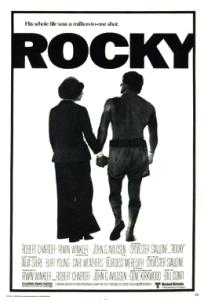
50th Academy Awards
- Annie Hall (1977 ) 5
- Close Encounters of the Third Kind (1977 ) 8
- The Spy Who Loved Me (1977 ) 3
- Airport ’77 (1977 ) 2
- Pete’s Dragon (1977 ) 2
- Oh, God! (1977 ) 1
- Saturday Night Fever (1977 ) 1
- Smokey and the Bandit (1977 ) 1
- The Absent-Minded Waiter (1977 ) 1
- The Rescuers (1977 ) 1
Star Wars
